Lugares de interés (POIs) del Mapa
48: Medina, Al-Masjid al-Nabawi 7-20th cent
Medina, Saudi Arabia
al-Masjid al-Nabawi. The Prophet's Mosque and Tomb
622 to the 20th cent
Architect Dar El Handasah

Photos copyright and Text see Archnet.org
The Mosque of the Prophet was built in 622 by the Muslim community after they reached the city of Yathrib, which would later be called al-Madina al-Muanwara. The mosque was situated next to the Prophet's house, and it consisted of a square enclosure of thirty by thirty-five meters, built with palm trunks and mud walls.
After the death of the Prophet, the mosque was enlarged to twice its size. In 707, by Umayyad Caliph al-Walid (705-715). Mamluk Sultans built the dome over the Prohets house and tomb and built and rebuilt the four minarets. The Ottomans (1517-1917) added and reconstucted the mosque until in the 20th cent the entire complex was remodeled and enlarged. - The mosque enclosure is one hundred times bigger than the first mosque built by the Prophet and can accommodate more than half a million worshippers.

Más sobre Medina, Al-Masjid al-Nabawi 7-20th cent
50: Mecca, Al-Masjid al-Haram - Great Mosque of al-Haram 1564-1572, 1955
Mecca, Saudi Arabia
al-Masjid al-Haram Great Mosque of al-Haram
1564, 1571-2, modern expansion in 1955
Ottoman

Photo from Archnet.org
Más sobre Mecca, Al-Masjid al-Haram - Great Mosque of al-Haram 1564-1572, 1955
51: Sana'a 13th-18th cent
Sana'a, Yemen
Sana'a is an architectural museum in its own right. Recently restored, its 13th-18th century buildings are unique.

Photo copyright and text see Archnet.org
Más sobre Sana'a 13th-18th cent
52: Sana'a Great Mosque - Jami al-Kabir 705-715
Sana'a, Yemen
Great Mosque - Jami al-Kabir
705-715
Omayyad
According to early sources, Prophet Muhammad commanded the construction of this mosque, including its location and dimensions, sometime around 630. While the validity of this claim lacks evidence and certainty, the mosque remains one of the first architectural projects in Islam. Sometime between 705 and 715, the Umayyid Caliph al-Walid I, rebuilt a new and larger mosque at the site.
Isma`ili Queen Arwa ibn Ahmad (12th cent) initiated an upgrade and restoration of the mosque. Towards this end she rebuilt its eastern wing complete with a new beautifully sculpted ceiling.


Interior with pre-Islamic columns

Coffered wooden ceiling (12th cent)

Text and photos from Archnet.org
Más sobre Sana'a Great Mosque - Jami al-Kabir 705-715
53: Sana'a Imam Salah al-Din Mosque1390
Sana'a, Yemen
Imam Salah al-Din Mosque
1390, minaret 16th cent

Photo and text from Archnet.org
Más sobre Sana'a Imam Salah al-Din Mosque1390
54: Sana'a, Al-Bakiriyya Mosque 1597
Sana'a, Yemen
Al-Bakiriyya Mosque
1597
Ottoman

Ornamented weight tower in the foreground with minaret behind to the right

Floor Plan showing the pendentives

Text and iImages from Archnet.org
Más sobre Sana'a, Al-Bakiriyya Mosque 1597
55: Qasr-ibn Warda 6th cent
Qasr-ibn Warda
6th cent

Photo by Forro Tibor from Panoramio
Más sobre Qasr-ibn Warda 6th cent
56: Anjar 705-715
Al Walid's Anjar Palace
705-715

Photo by Gregory Zdaniuk from Panoramio
Más sobre Anjar 705-715
57: Qasr al-Kharrana 710
Quasr al-Kharrana
710
Omayyad

Photo by ToniFarre from Panoramio
Más sobre Qasr al-Kharrana 710
58: al-Minya 710
Palace of al-Walid I's (710). Square castle with round towers in the corners, a Mihrab, the cupola partly preserved, rich ornaments, floor carpet-mosaics.
Exact location uncertain
Más sobre al-Minya 710
59: Qasr al-Amra 712 - 715
Qasr al-Amra, Jordan
712-715
Charming, well-preserved small "red castle" built for Omayyad Caliph al-Walid Architecturally the large throne room resembles a 3-nave Byzantine church. Attached are warm- and hot-steam baths. extensive murals - in poor shape - depict Persian Shah Khosrau, the remperor of Byzantium, and other famous rulers of the world (Persian influences?), the colors of the murals remind of those preserved from Dura-Europos (Museum Damascus). The surprise in the nudity-hostile Islamic-Arabic world, are the bathing and pleasure scenes in lovely garden murals: The pleasures of Paradise on this Earth!

Text and photo from Wikipedia
Más sobre Qasr al-Amra 712 - 715
60: Qasr al-Hallabat and Sarakh Baths 709-750
Qasr al-Hallabat and Sarakh Baths, Jordan
Omayyad Palace
709-750
Approximately 1400 meters east of the palace stand the remains of the mosque at Qusayr al-Hallabat constructed of layered limestone.
The bath located approximately two kilometers east of the main site is known as Hammam as-Sarakh and consists of a rectangular audience hall, and a bath. It is reminiscent of Qsar 'Amra in plan.

Text and photo from Archnet.org
Más sobre Qasr al-Hallabat and Sarakh Baths 709-750
61: Kirbat al-Mafdjar 724
Kirbat al-Mafdjar 724

Photo by jsahouri frrom Panoramio
Más sobre Kirbat al-Mafdjar 724
62: Qasr al-Hayr al-Gharbi 724-743
Qasr al-Hayr al-Gharbi
724-743

Photo by saleemhaijjar from Panoramio
Más sobre Qasr al-Hayr al-Gharbi 724-743
63: Qasr al Hayr ash Sharqi 740
Qasr al Hayr ash Sharqi
Impressive ruins of a pleasure castle of Calif Hisham (7724-43).

Photo by saleemhaijjar from Panoramio
Más sobre Qasr al Hayr ash Sharqi 740
64: Qasr al-Mshatta 743-734
Qasr al-Mshatta, Jordan
743-734

Photo and text from Archnet.org
The most beautiful feature of Mshatta, however, remains in the rich and intricately carved features on its southern exterior, a significant section of which was given to Kaiser Wilhelm as a gift from the Ottoman sultan 'Abd al-Hamid just before World War I . These reconstructed ornamental sculptures from the gates are the piece-de-resistance of the Islamic Museum in Berlin:
.jpg)
Photo from Wikipedia
Más sobre Qasr al-Mshatta 743-734
65: al-Azraq 8th cent
Al Azraq large desert castle, not a pleasure palace!
Más sobre al-Azraq 8th cent
66: Jerusalem Dome of the Rock 687-691
The Dome of the Rock, Masjid Qubbat As-Sakhrah
687 - 691
The Dome was built between 687 and 691 by the 9th Caliph, Abd al-Malik, making it the oldest extant Islamic building in the world. It is in the shape of a Byzantine martyrium, a structure intended for the housing and veneration of saintly relics and is an excellent example of middle Byzantine art. During the reign of Suleiman the Magnificent (1520 - 1566) the exterior of the Dome of the Rock was covered with Iznik tiles. The work took seven years.
The rock in the center of the dome is the spot from which, according to Islamic tradition, Muhammad ascended for a night-long journey to Heaven in AD 621, accompanied by the angel Gabriel.
In 1955-1964 an extensive program of renovation was begun by the government of Jordan, with funds supplied by the Arab governments and Turkey. The work included replacement of large numbers of the Iznik tiles. In 1960, as part of this restoration, the dome was covered with a durable aluminium and bronze alloy made in Italy.

Photo from Wikipedia
Más sobre Jerusalem Dome of the Rock 687-691
67: Damascus Omayyad Mosque 706-715
Damascus
The Great Omayyad Mosque
706-715
During Roman times the site was a temple of Jupiter which was in the Byzantine era converted into a Christian church dedicated to John the Baptist. The Muslim conquest of Damascus in 636 did not affect the church, as the site was shared by Muslim and Christian worshippers. The Umayyad caliph Al-Walid I purchased the site and demolished the church. He built the present mosque between 706 and 715 with the help of 200 skilled Byzantine workers: e.g., the mosaics in the overlong (136 x 37 m) prayer hall. Most of this interior decoration was lost in a great fire in 1893. The mosaics on the outside are of recent date.
The building is a simple solution for the Islamic need for a space in which all could face Mekka and see the quibbla. It has been copied in a number of places (e.g. the Great Mosque of Diyarbakir, Turkey). Another early scheme to achieve the same goal is the Mesquita in Cordoba, Spain.

Interior

Photo kaizergallery.com

Floor plan from Archnet.org
Más sobre Damascus Omayyad Mosque 706-715
68: Cordoba Mesquita 785-987
Cordoba Mesquita
The Great Mosque of Cordoba 785-987
The construction of the Mesquita (originally the Aljama Mosque) took over two centuries, starting in 784 A.D. under the supervision of the first Emir Abd ar-Rahman I, who built it as an adjunct to his palace - and named it to honor his wife - on the site of the Visigothic cathedral of St. Vincent. The mosque underwent numerous subsequent changes: Abd ar-Rahman III built a new minaret, while Al-Hakem II, in 961, enlarged the plan of the building and enriched the mihrab. The last changes were carried out by Al-Mansur Ibn Abi Amir in 987.

Photo by Jorgen K H Knudsen Panoramio
In 1236 Cordoba was "liberated" by King Ferdinand III of Castile. The Mesquita was reconsecrated as a Christian church. Alfonso X oversaw the construction of the Villaviciosa Chapel and the Royal Chapel within the structure of the mosque. The most significant alteration was the construction of a Renaissance cathedral in the middle of the structure by Charles V (1530s). Still this reversion to a Christian church (officially the "Cathedral of the Assumption of the Virgin") may have preserved the Mesquita. Charles V is known to have greatly admired the Mesquita.
The Mesquita is one of the most beautiful sacred spaces in the world, and Charles V's insertion of an entire cathedral only underscores the peace and quiet of the Islamic architecture.

Photos and plan Alfred Renz, op. cit.
Más sobre Cordoba Mesquita 785-987
69: Cordoba Medina Azahara 936-948
Medina Azahara (Medinat al-Zahara)
936-948
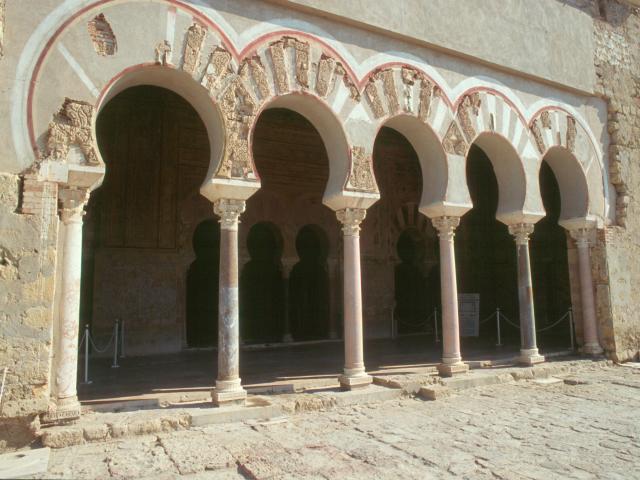
Photo and text colgate.edu
Más sobre Cordoba Medina Azahara 936-948
70: Kairouan, Great Mosque 724-728
Kaiouran, Tunisia
Great Mosque
724-728
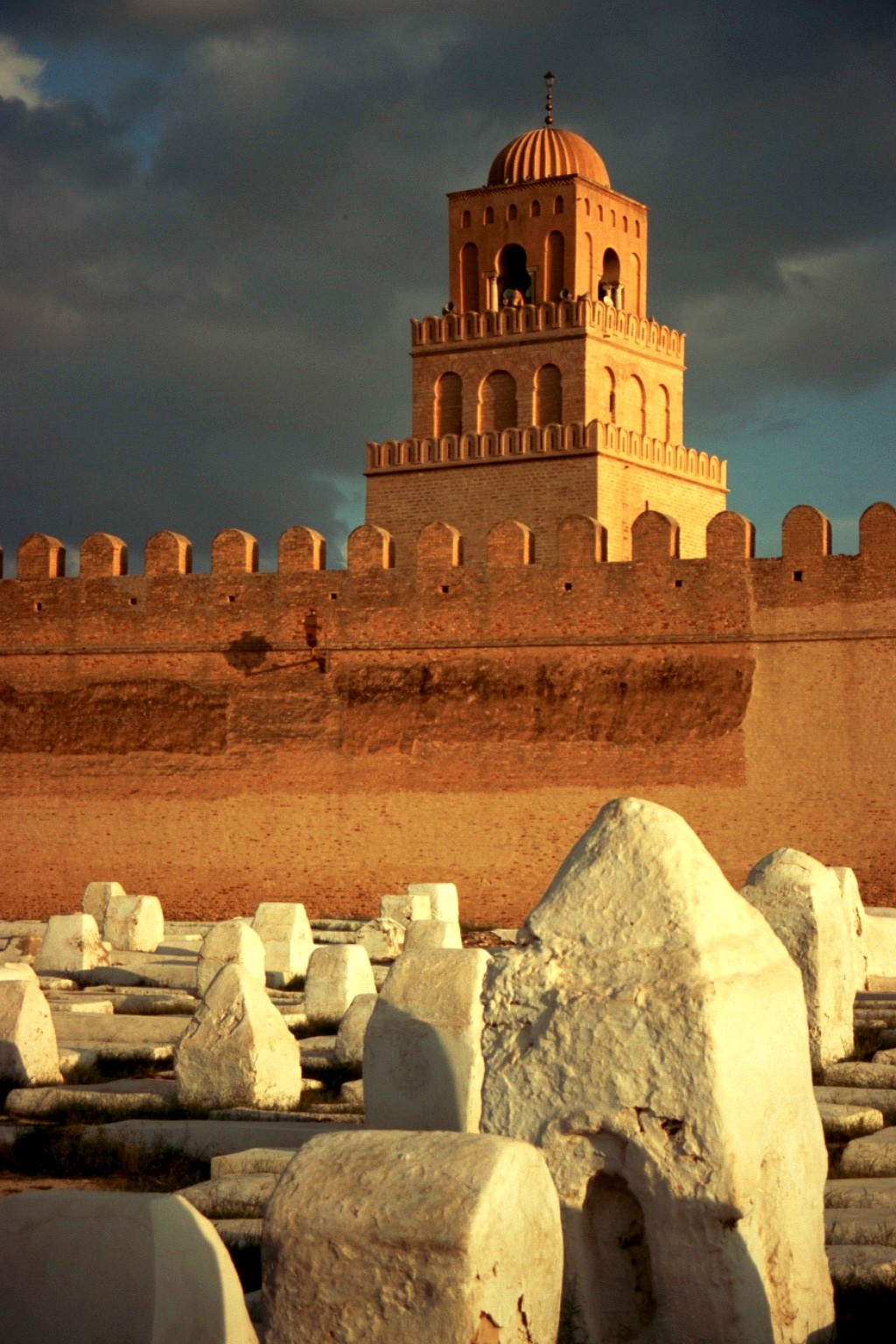
Photo from Wikipedia < BR>
Más sobre Kairouan, Great Mosque 724-728
71: Sousse, Ribat 796
Sousse, Tunisia
Ribat (Castle)
796

Photo from Girksoloinaerabia
Wall enclosure and gate

Photo from thais.com
Más sobre Sousse, Ribat 796
72: Sousse, Great Mosque 9-10th cent
Sousse, Tunisia
Great Mosque
9-10th cent
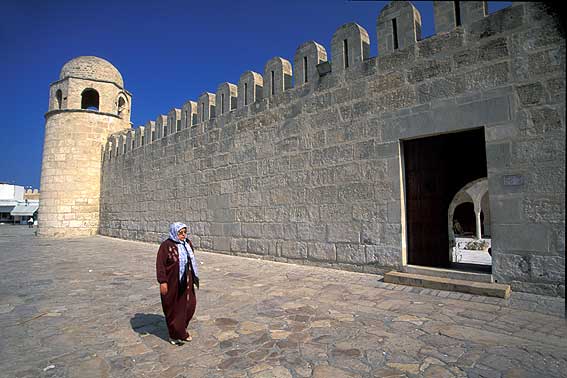
Más sobre Sousse, Great Mosque 9-10th cent
73: Algiers Great Mosque 1096
Algiers, Algeria
Great Mosque
1096
Hammadid
Photo wbphotos.com
The floorplan is reminicent of the Mesquita in Cordova

Plan from Archnet.org
Más sobre Algiers Great Mosque 1096
74: Sfax, Grand Mosque 10th cent
Sfax, Tunisia
Grand Mosque
10th cent

Photo from i-cias.com/tunisia
Más sobre Sfax, Grand Mosque 10th cent
75: Samarra, al-Muttawikil 847-892
Samarra, Iraq
al-Muttawikil
847-892
Abbasid
The main remaining curiosity is the Minaret al-Malwiya, approximately 55 meters high. Although round in shape, this minaret is influenced by a specific type of Mesopotamian ziggurat, square-planned and featuring stairs or an incline on the exterior of its fa�§ade while rotating several times until reaching the crown.

Photo and text Archnet.org
Más sobre Samarra, al-Muttawikil 847-892
76: Damghan, Masjid-i Tarik Khana 750-789
Damghan, Iran
Masjid-i Tarik Khana
750-789
Abbasid

Interior

Más sobre Damghan, Masjid-i Tarik Khana 750-789
77: Ktesiphon Taq-i-Kisra 7-8th cent?
Ktesiphon, Iraq
Taq-i-Kisra
7-8th cent?

Phtoto Livius.org
The last remains of Ktesiphon is the great arch of Taq-i-Kisra ("Arch of Chosrau") (Sassanid, 7-8th cent?). The technology of erecting large arches over square or rectangular bases seems to have come with the Parthians from Khorassan. The Romans only knew how to erect copulas on circular tambours. The "Iranian" cupola using spherical Pendentives reached Byzantium in the 6th cent (Aghia Sofia) and Western Europe only in the Renaissance (Brunelleschi's dome in Florence). See also Bukhara.
Más sobre Ktesiphon Taq-i-Kisra 7-8th cent?
78: Cairo, Ibn Tulun Mosque 870-879
Cairo
Ibn Tulun Mosque
870-879
Tulunid
All Photos and text from Archnet.org

The spiral minaret

Andalusian horese-shoe door. Entry to minaret.

Más sobre Cairo, Ibn Tulun Mosque 870-879
79: Cairo Al Azhar Complex 970-972
Cairo, Egypt
Al Azhar Mosque
970-972
Fatimid<
The courtyard was originally enclosed with three arcades. Caliph al-Hafiz (1138) added an arcade around all four sides of the courtyard, displaying keel-shaped arches, roundels, and keel-arched niches.

Photo from islamicarchitecture.org
Más sobre Cairo Al Azhar Complex 970-972
80: Cairo, Mosque of Caliph al-Hakim bin Amr Allah 990-1004
Cairo, Egypt
Mosque of Caliph al-Hakim bin Amr Allah
990 - 1004
Fatimid
Text, plan, and photo from Archnet.org

Isometric view

Más sobre Cairo, Mosque of Caliph al-Hakim bin Amr Allah 990-1004
81: Bukhara Samanid Mausoleum 914
Bukhara
Samanid Mausoleum
914
The Samanid Mausoleum in Bukhara, built by Nasr ibn Ismail (914) square canopy tomb is the earliest Islamic monument in Central Asia. It exhibits especially the unique architectural solution of the support of the dome, which differs from Westen examples.
The technology of erecting large parabolic arches or domes over square or rectangular bases seems to have come with the Parthians from Khorassan. The Romans only knew how to erect copulas on circular tambours. The "Iranian" cupola using spherical Pendentives reached Byzantium in the 6th cent (Aghia Sofia) and Western Europe only in the Renaissance
Photos from http://ocw.mit.edu

The unique eastern squinch (Pendentive) in the support of the dome on a square base.

Más sobre Bukhara Samanid Mausoleum 914
82: Balkh No-Gumbad Mosque 925
Balkh, Afghanistan
No-Gumbad Mosque
925
Abbasid-Samanid
The forest of stucco-covered columns, standing in 3 feet of rubble is still extant.

Photo and floor plan from Archnet.org
Floor plan

Más sobre Balkh No-Gumbad Mosque 925
83: Na'in Masjid-i-Jame 960
Na'in, Esfahan, Iran
Masjid-e Jame
960
Buyid
The minaret represents an important transition from the early square form to the Iranian minarets of the 11th and 12th centuries. Maintaining the early square plan at the base, a tall tapering octagonal mid-section rises to a short cylindrical shaft.
The Masjid-e Jame at Na'in is renown for the extensive and masterful carved stucco of the mihrab and adjacent bays, including the oldest extant epigraphic friezes in Iran. Stylistically it bridges the stucco decoration of the Sasanian and Abbasid periods with that of the Seljuks.

External view from the southeast including the mirab:

<
Elaborate carved stucco decorations around the mirab

Más sobre Na'in Masjid-i-Jame 960
84: Ardestan Masjid-i Jami 10-11th cent
Ardestan, Esfahan, Iran
Masjid-i Jami
10-11th cent
pre-Seldjuk to early Seldjuk transition
Il-Khan-Mongolic(?) influences and Safavid dome (1539)
Text and photos from Archnet.org

Courtyard and arcades.

However, the arcades as they stand cannot be dated to the pre-Seljuk original, as they include domed and barrel vaults that display wide variety in brickwork, height, and shape, the supporting piers are also ranging in size and shape.
View of vaults in the oldest part of the complex (view through the arch to the southeast iwan)

The earliest stucco fragments, found in the western corner of the courtyard, have been dated to the end of the tenth century. The interior of the dome chamber and iwan are extensively covered in plaster. The dome and zone of transition are articulated with simulated brickwork; the iwan vault is uniquely faced with a complex stucco design of interlacing arabesques. The mihrab exemplifies skilled stucco carving, and may represent Mongol restoration.

Más sobre Ardestan Masjid-i Jami 10-11th cent
85: Damghan Chihil Dukhtaran Gunbad Tomb 1056
Damghan, Iran
Chihil Dukhtaran Gunbad
1056
Seldjuk Tomb
Built in the year 1054-55, this monument is the second oldest remaining tomb structure from the time of Tughril Beg (1040-1063), the first Seljuk monarch.

Más sobre Damghan Chihil Dukhtaran Gunbad Tomb 1056
86: Konya Alaeddin Mosque 1219-1238
Konya, Anatolia
Alaeddin Mosque, 'Ala al-Din Kayqubad I Camii1150-1220,
Seldjuk
Evidence of an early building program dates from the time of Mesud I. An inscription dates the fine, ebony minbar to 1155; the minbar is the first dated example of Seljuq art in Anatolia. The polychrome ceramic frame of the mihrab and the dome above may date to this period.
Kaykaus I began a major rebuilding program in 1219. He changed the main entrance from the west to the north, opposite the mihrab. He added a monumental fa�§ade on the north side, overlooking the city and facing the Seljuq palace. A marble tomb was begun in the courtyard. Kaykausâ�� building was cut short by his death in the same year, only to be resumed thereafter by his brother and successor Kayqubad I.
With the exception of Izzeddin Keykavus, all of the Seljuk sultans after 1156 are interred in the complex.

North facade. The white stone columns are reused from a Byzantine building.

Interior: the peristile prayer hall.

Más sobre Konya Alaeddin Mosque 1219-1238
87: Konya Karatay Medresa 1251-1252
Konya, Anatolia
Karatay Medresa
1251-1252
Seldjuk

The polychrome marble entry.

The tiled dome.The triangular penditives, known as Turkish triangles, are an architectural speciality of the Rum Seldjuks.
Photo Rolf Gross 1990
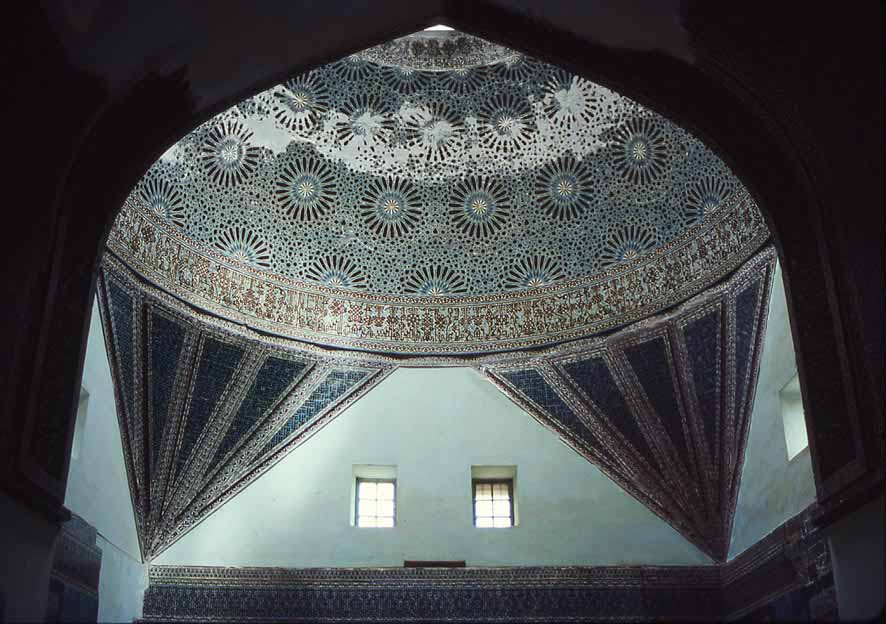
Más sobre Konya Karatay Medresa 1251-1252
88: Konya Ince Minareli Medrese 1260-1265
Konya, Anatolia
Ince Minareli Medrese, Dar al-Hadith
1260-1265
Seldjuk
However, the extraordinary feature of this medresa is its sculptural decorations.
Main Portal with folded inscription.
Photos from Archnet.org

Base of the minaret.

Más sobre Konya Ince Minareli Medrese 1260-1265
89: Konya Mevlana Tekke 1270s, 1512-1520
Konya, Anatolia
The Mevlanan Tekke
1270s, 1512-1520
Seldjuk, Ottoman
The earthen graves of Mevlana and his father were soon after Rumi's death covered with a shrine, and a Tekke (takiyya) was built around the tombs to house the Mawlawi brotherhood.
The first tomb built over Mevlana's grave, a simple domed structure, was commissioned in 1274 by Gurcu Hatun, wife of Seljuk vizier Suleyman Pervane and built by Tabrizi architect Badr al-Din. In 1397, Karamanid ruler Ala' al-Din Ali Bey (1361-1398) replaced the dome with the sixteen-sided conical crown covered with green tiles. The shrine grew with additions and redecorations during the rule of Ottoman sultan Bayezid II (1481-1512). Between 1983 and 1987 the complex was extensively restored.
For a collection of 129 beautiful images see Archnet.org Photos of the Mevlana Museum to which I owe the following images - except the first.
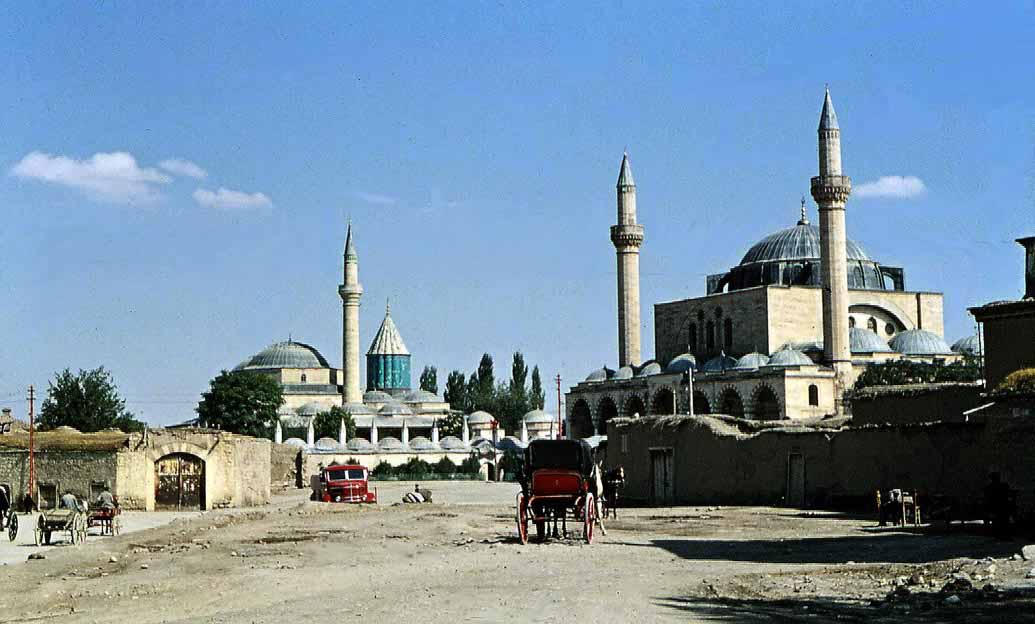
Essentially the same view 1970. All following photos from Archnet.org

View from west showing lead-covered domes of the Dervish Tekke, with its chimneys. The green tiled Turbe of Rumi's shrine is seen behind.

Western wall of shrine facing the takiyya courtyard, with tomb of Sultan Velid seen in front.

The gilt sarcophagus of Mevlana and his son Sultan Veled.


Más sobre Konya Mevlana Tekke 1270s, 1512-1520
90: Konya Selimiye Camii 1558-1567
Konya
Selimiye Camii
1558-1567
Ottoman
Built by Sultan S�¼leyman I or by his son Selim II as prince.

Photo from Archnet.org
Más sobre Konya Selimiye Camii 1558-1567
91: Aksaray Ulu Camii 11th cent.
Aksaray
Ulu Camii
11th cent
Seljuk


Photos fromDick Osseman, Aksary
Más sobre Aksaray Ulu Camii 11th cent.
92: Agizkara Han Caravansaray 13th-14th cent
Agizkara Han near Aksaray, Cappadocia
Caravansaray
13th-14th cent
Seldjuk
The religious compounds of Islam alaways contained buildings which seved social purposes: besides medrese, Islamic schools, there was usually a "hospital" primarily to care for the mentally ill - who spoke in tongues! - soup kitchens for the poor, and a caravanseray to accomodate travelers and their camels. The income form which helped support the külliye foundations. - Before the 14th cent Byzantine Orhodoxy had similar institutions in a few places.
The Seldjuks built a number of such Hane along the caravan routes in Turkey. One near Akseray is shown below..


Photos Archnet.org
Más sobre Agizkara Han Caravansaray 13th-14th cent
93: Sivas Gök Medrese !271
Sivas, Anatolia
Gök Medrese
1271
Seljuk
The richness of its Seljuk decorations on its outer walls:




Text from Archnet.org, all photographs from Dick Osseman
Más sobre Sivas Gök Medrese !271
94: Sivas, Ã?ifte Minareli Medrese 1271
Sivas, Turkey
Ã?ifte Minareli Medrese
1271
Il-Khanid - Seljuk
View of Ã?Â?ifte Minaret Madrasa (left) and Izzeddin Keykavus Hospital (right), with Kale Mosque in the background, looking north

Text and Photos Archnet.org
Más sobre Sivas, Ã?ifte Minareli Medrese 1271
95: Diyarbakir Ulu Camii 1091-1092
Diyarbakir, Turkey
Ulu Cami
1091-1092
Architects Hibat Allah al Gurgani, Selame oglu Mehmet
included in the complex are the Mesudiye Medresesi (1193) and, not connected to the courtyard, the Zinciriye Medresesi (1189) .
Text and photo from Archnet.org

View of the western wing of the prayer hall.

Más sobre Diyarbakir Ulu Camii 1091-1092
96: Uc Kumbetler Three Tombs 1081-1102
Erzurum
Uc Kumbetler
Three Mausolea
12th century
Saltukid-Seljuk

Detail of a window in Emir Saltuk's Tomb remindful of contemporary 12th cent Armenian decorations, e.g. in Ani:

Más sobre Uc Kumbetler Three Tombs 1081-1102
97: Erzurum Ulu Camii 1179
Erzurum
Ulu Cami - Great Mosque
Saltukid 1179
Architect: Abu'l-Fath Muhammed
The Great Mosque of Erzurum was commissioned by Saltuk Emir Nasrettin Aslan Mehmet in 1179. Substantial alterations took place in 1639, in 1839 by Sultan Mahmut II, in 1860, and the last in 1957-1964. These repairs have resulted in numerous modifications especially of the old dome. A portion of the central aisle and large sections of the qibla wall are remaining from the original Saltukid mosque.
An interesting feature is the timbered dome structure obtained by stacking planks in the way shown in the photo. This method was still in use in Georgia in the 19th cent. It may go back to Indian (Kashmir) and Central Asian (Serindia) practices of the 7th cent. AD
Photo from Archnet.org

Más sobre Erzurum Ulu Camii 1179
98: Erzurum Ince Minarets Medrese 1270s
Erzurum
Ince Minarets Medrese, Hatuniye Medresesi
1275
The medrese has two minarets remindful of Timurid medrese in Samarkand.
Photo by Struifje, Panoramio.

Text and floor plan from Archnet.org

Más sobre Erzurum Ince Minarets Medrese 1270s
99: Cairo Citadel and Mosques 1176-1183.
Cairo
Citadel and Mosques
1176-1183, enlarged in 13th-14th cent
Ayyubid, Mamluk, Ottoman
The large mosque visible on GE in the Ayyubid citadel is the much later Mehmet Ali Mosque (Ottoman, 1824-57)

Photo Archnet.org
Más sobre Cairo Citadel and Mosques 1176-1183.
100: Cairo, Madrasa of Amir Khayerbak 1250-1517
Cairo
The Madrasa of Amir Khayerbak:
1502-1520
Mameluk

Photo ocw.mit.edu
Más sobre Cairo, Madrasa of Amir Khayerbak 1250-1517
101: Tlemcen Great Mosque 1136
Tlemcen, Algeria
Great Mosque
1136
Almoravid
The Great Mosque of Tlemcen was built by Sultan Ali ibn Yusuf in 1136. It is one of the best preserved examples of Almoravid archictecture.
For a details on the Mosque of Tlemcen seeMuslim Heritage, Tlemcen (the article cannot be copied!)
Más sobre Tlemcen Great Mosque 1136
102: Marrakech Kutubiya Mosque 1150
Marrakech, Marocco
Kutubiya Mosque
1150

Photos dart.columbia.edu
Más sobre Marrakech Kutubiya Mosque 1150
103: Melika Great Mosque 12-13th cent
Melika, Algeria
Great Mosque
12-13th cent
Almohad
An unusual mosque in the middle of the desert



Photos (1983) Archnet.org
Más sobre Melika Great Mosque 12-13th cent
104: Fez, Masjid al-Qarawiyyin 859-60; 956; 1135;
Help!: The location of the placemarker is Not on the mosque!!
Fez, Morocco
Masjid al-Qarawiyyin,
859-60; 956; 1135; 17th cent
Alawi, Almoravid, Idrisid
Visual references to the religious and palatine architecture of Islamic Spain are evident in the mosque's hypostyle plan, the 10th century square stone minaret (commissioned and funded by 'Abd al-Rahman III, the first Umayyad caliph of al-Andalus), and by the carved stucco, wood, and glazed tile (zilij) ornamental style derived from the Alhambra.
The Mosque of al-Qarawiyyin, is one of the world's oldest universities. Founded as a private oratory in 857 by Fatima, the daughter of a wealthy Qayrawani immigrant, the mosque is surrounded by madrasas, and was a major intellectual center in the medieval Mediterranean. Its prestigious academic reputation may have transcended religious divisions, if, as a popular tradition suggests, Gerbert of Auvergne (930-1003), who would become Pope Sylvester II and who is credited with introducing Arabic numerals to Europe, was once a student at al-Qarawiyyin. (from Wikipedia)

Photo Archnet.org
Más sobre Fez, Masjid al-Qarawiyyin 859-60; 956; 1135;
105: Rabat, Hassan Mosque (ruins) 1184 - 1199
Rabat, Morocco
Hassan Mosque (ruins)
1184-1199
Almohad
Text and photos Archnet.org


Más sobre Rabat, Hassan Mosque (ruins) 1184 - 1199
106: Sevilla Giralda 1195
Sevilla, Andalucia
Great Mosque - Cathedral of Seville
Giralda
1172-1176, Giralda 1184
The Giralda, the Court of the Oranges, and the Gate of Pardon were integrated into the new composition of the new Gothic cathedral which was completed in the sixteenth century.
Photos Rolf Gross
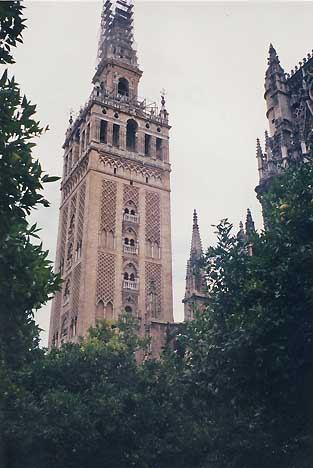
View of the courtyard from the tower.
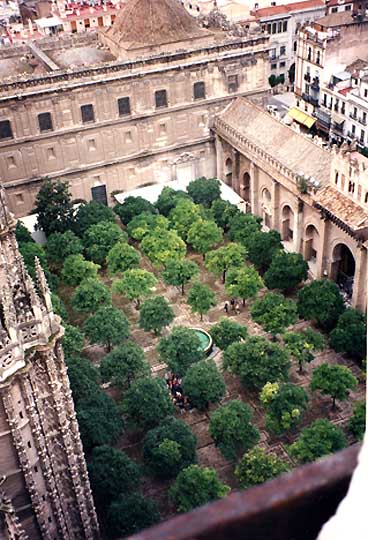
Más sobre Sevilla Giralda 1195
107: Berlanga Hermitage of San Baudelio 12th cent.
Berlanga, Spain
Hermitage of San Baudelio
12th cent
Mozarab
By the end of the thirteenth century, the church had undergone two cycles of painting, leaving its interior surfaces completely adorned with frescoes. Some of these murals depict the life of Christ while others feature animals, such as the camel, and scenes of hunting, influenced by popular themes and motifs during the tenth century Umayyad caliphate.


Text and Photos Archnet.org
Más sobre Berlanga Hermitage of San Baudelio 12th cent.
108: Taza, Great Mosque 1291-92
Taza
Great Mosque
1291-92
Inaccessible to non-Moslems
Más sobre Taza, Great Mosque 1291-92
109: Granada Alhambra 1332-54
Granada, Spain
The Alhambra
1332-54
The Alhambra from the Albaicin Hill
Photo Rolf Gross, 1997
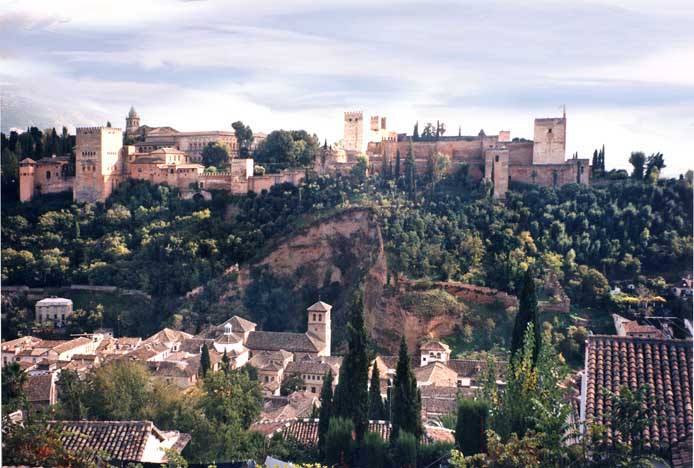
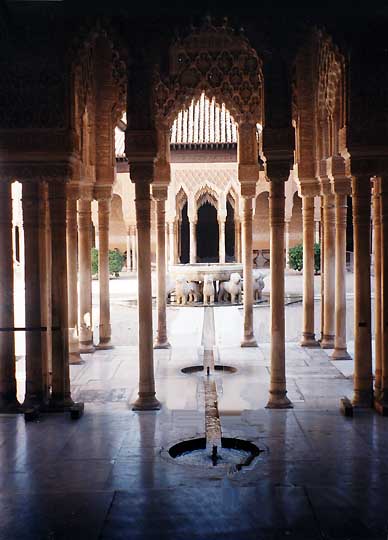
Photo Rolf Gross, 1997
Water everywhere, in runnels in the rooms, reflections in pools in the courtyards

Photo Andy Radin
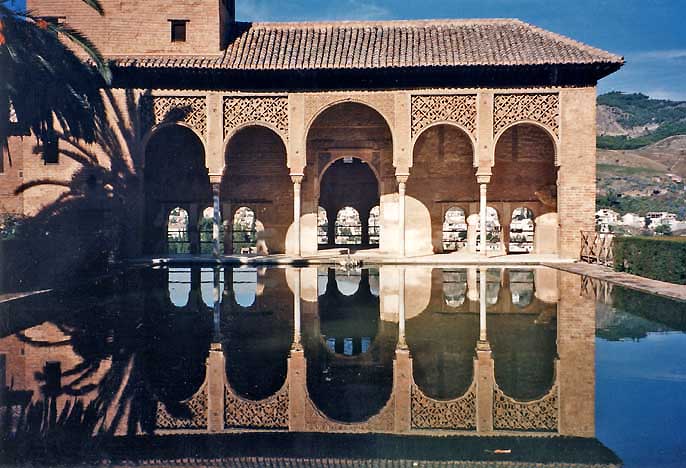
Photo Rolf Gross 1997
Más sobre Granada Alhambra 1332-54
110: Palermo San Giovanni degli Eremiti 6th cent
Palermo, Sicily
San Giovanni degli Eremiti
6th cent
The church's origin predate the Arabic and the Norman conquests. After the Islamic conquest of Sicily, its church was turned into a mosque. Its domes date from that time. The Normans returned it to the monks of St. William from Vercelli around 1136

Photo Wikipedia
Más sobre Palermo San Giovanni degli Eremiti 6th cent
111: Palermo Castello dela Zisa 12th cent
Palermo, Sicily
Castello dela Zisa
12th cent

Niche with fountain in the main hall.

Photo Wikipedia
Más sobre Palermo Castello dela Zisa 12th cent
112: Palermo Cappella Palatina 1130-1143
Palermo, Sicily
Capella Palatina
1130-1143
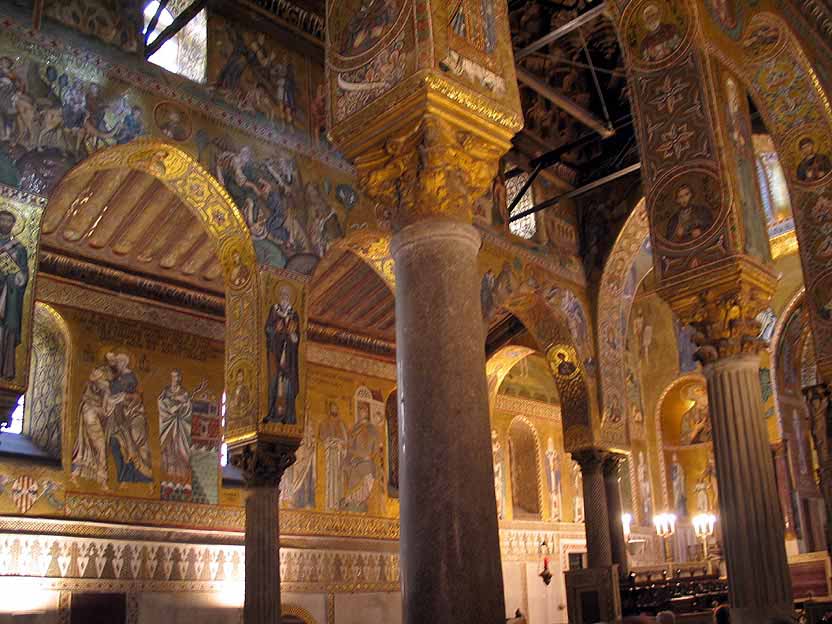
Photo Rolf Gross's collection of the Capella Palatina.
Más sobre Palermo Cappella Palatina 1130-1143
113: Castelvetrano S.S. Trinita di Delia 12th cent
Castelvetrano, Sicily
S.S. Trinita di Delia
12th cent
Photo Rolf Gross
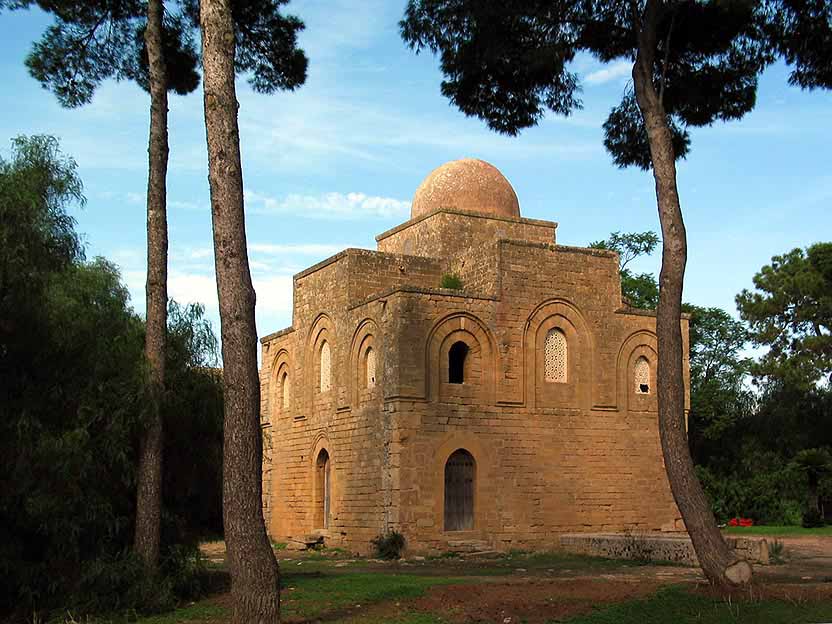
Más sobre Castelvetrano S.S. Trinita di Delia 12th cent
114: Sang Bast, Arslan Jadhib Gunbad 997-1028
Sang Bast, Iran
Arslan Jadhib Gunbad
997-1028
Ghaznavid
The burial site of Arslan Jadhib, an official of the Ghaznavid Sultan Mahmud, was originally incorporated into a larger complex along with the nearby freestanding minaret.
Text and photo Archnet.org

Más sobre Sang Bast, Arslan Jadhib Gunbad 997-1028
115: Chisht-i-Sharif, Gumbad, Mausolea 1167
Chisht-e Sharif, Khorasan, Afghanistan
Gumbad of Chesht
Two Mausolea
1167
Ghurid
Text and photos Archnet.org


The squinches (pendentives) in the corners of the cube.

Más sobre Chisht-i-Sharif, Gumbad, Mausolea 1167
116: Bukhara, Magokh-i-Attar Mosque 1178-1179
Bukhara, Uzbekistan
Magokh-i-Attar Mosque
8th cent and 1178-1179
Qarakhanid
The mosque's origins, like many others in Bukhara, are mysterious and legend-laden. The site is now understood to have once formed the core of Bukhara's city center (Shahristan) in the early Sogdian era. The site was occupied in the 5th century by a Zoroastrian temple, which was replaced by a Buddhist temple. An important temple dedicated to Moh, the moon deity, and a market surrounding it stood there until a conflagration in 937. Nothing has remained from these earlier buildings. The southern portal, which is the oldest component of the present structure, can be traced to the Qarakhanid dynasty's extensive rebuilding in the twelfth century.

Más sobre Bukhara, Magokh-i-Attar Mosque 1178-1179
117: Herat Masjid-i Jamii - Great Mosque 1200-1498 (1970)
Herat - Chorasan, Afghanistan
Herat Masjid-i Jamii - Great Mosque
1200, 1498
Ghurid

Más sobre Herat Masjid-i Jamii - Great Mosque 1200-1498 (1970)
118: Mashhad, Imam Ali Reza Shrine 14-20th cent
Mashhad
Khorasan, Iran
Imam Ali Reza Shrine
14-20th cent
Timurid
Although the earliest present structures date from the the early 15th cent, historical references indicate buildings on the site prior to the Seljuk period, and a dome by the early thirteenth century.
Following periods of alternating destruction and reconstruction, including the sporadic interest of Seljuk and Il-Khan Sultans, the largest period of construction took place under the Timurids and Safavids. The site received substantial royal patronage from the son of Timur, Shah Rukh, and his wife Gawhar Shad and the Safavid Shahs Tahmasp, Abbas and Nader Shah.

Street view from the south, with the blue dome of the Gawhar Shad Mosque and the gold sanctuary dome way in back. As can be seen from outer space the complex is large.

Text and photos Archnet.org
Más sobre Mashhad, Imam Ali Reza Shrine 14-20th cent
119: Ghazni, Ulugh Begh and 'Abd al-Razzaq Mausoleum 1460-1502
Ghazni, Afghanistan
Ulugh Begh and 'Abd al-Razzaq Mausoleum
1460-1502
Timurid

The mausolum has an unusual floor plan.

Text and phots Archnet.org
Más sobre Ghazni, Ulugh Begh and 'Abd al-Razzaq Mausoleum 1460-1502
120: Balkh, Khwaja Abu Nasr Parsa Mosque 1460 to 1598
Balkh, Afghanistan
Khvaja Abu Nasr Parsa Mosque and Tomb
1460 to 1598
Safavid
Khwaja Abu Nasr Parsa (d. 1460) was a spiritual leader of the Naqshbandi order and a theological lecturer in Herat. Golombek and Wilber have identified an unmarked tombstone in front of the portal as the khwaja's grave marker.


The Spiral column after the last restoration in 1975

Text and photos Archnet.org
Más sobre Balkh, Khwaja Abu Nasr Parsa Mosque 1460 to 1598
121: Na'in, Masjid-i Baba 'Abd Allah 1300, restored 1336
Na'in, Esfahan, Iran
Masjid-i Baba 'Abd Allah
1300, restored 1336
A rare Il-Khanid example

Interior, painted decorations and inscription

Text and photos Archnet.org
Más sobre Na'in, Masjid-i Baba 'Abd Allah 1300, restored 1336
122: Sultaniya, Mausoleum of Il-Khan Oljeitu 1307-1313
Sultaniyya, Iran
Mausoleum of Sultan Muhammad Oljeitu Khudabanda
1307- 1313
Il-Khanid
The structure, erected between 1307 and 1313, boasts the oldest double-shell dome in the world. Its importance in Islamic architecture may be compared to that of Brunelleschi's Florentine cupola for the West. The Dome of Soltaniyya paved the way for more daring Muslim cupola constructions, such as the Mausoleum of Khoja Ahmed Yasavi and Taj Mahal. Much of the exterior decoration has been lost, but the interior retains superb mosaics, faience, and murals.
The mausoleum under reconstruction in 1999.


Polichrome plaster in the vault

Text and photos Archnet.org
Más sobre Sultaniya, Mausoleum of Il-Khan Oljeitu 1307-1313
123: Shiraz, Shah Cheragh Shrine 14th cent
Shiraz, Iran
Shah Cheragh Shrine
Syed Amir Ahmad (also called Ahmad ibn Musa)
14th cent
Ilkhanid

Text and photo Archnet.org
Más sobre Shiraz, Shah Cheragh Shrine 14th cent
124: Kerman, Masjid-i-Pa Minar 1390
Kerman, Iran
Masjid-i-Pa Minar, Pa Pinar Mosque
1390
Il Khanid
exact location uncertain
Entrance to shrine

Photo Archnet.org
Más sobre Kerman, Masjid-i-Pa Minar 1390
125: Yadz Masjid-e Jame 1324, 1364-1470
Yadz, Iran
Masjid-e Jame
1324, 1364-1470
Muzzafarid, Timurid
The mosque is also significant for the early and substantial use of transverse vaulting in the rectangular winter prayer halls, a system that also has precedents in Sasanian structures.
The tile decoration is also noteworthy, although much is restoration. The dome is articulated with geometric decorative brickwork in turquoise and white on an unglazed buff field. Decorative brickwork laid in epigrams cover most wall surfaces within the sanctuary, above a turquoise tile dado with mosaic medallions that continues into the iwan. The mihrab is sheathed with naturalistic vegetal designs rendered in remarkable faience mosaic.


Vaulting in the eastern gallery

Text and photos Archnet.org
Más sobre Yadz Masjid-e Jame 1324, 1364-1470
126: Abarquh Masjid-e Jame 1337-1338
Abarquh, Iran
Masjid-e Jame
1337-1338
Il-Khanid, Timurid

Interior

Photos Archnet.org
Más sobre Abarquh Masjid-e Jame 1337-1338
127: Samarkand, The Registran
Samarkand
Moon rise over the Registran. Photo 1989
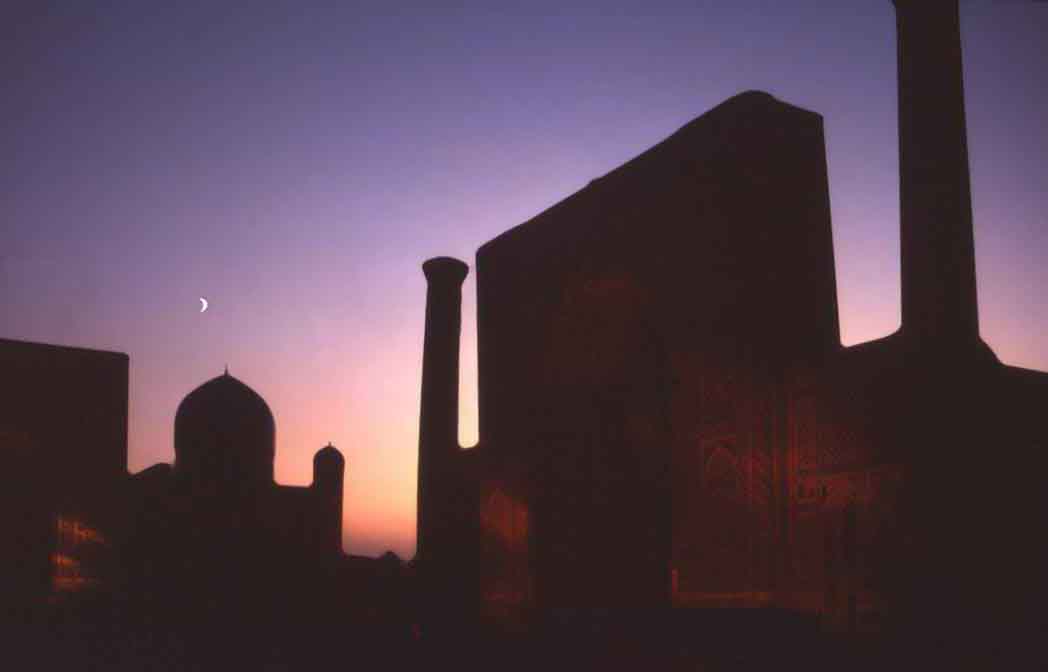
For more photos from Samarkand go to Rolf's Samarkand 1977 and 1989
Más sobre Samarkand, The Registran
128: Samarkand Bibi-Khanum Mosque 1398-1405
Samarkand, Uzbekistan
Bibi Khanum Mosque - Masjid-i-Jami
1398-1405
Timurid
Photo of the mosque from the street after its dome and Ivan had been restored (1990s)

Photo Archnet.org
Before the last reconstruction (19870s-80s) only four massive fragments like enormous teeth and a minaret had survived of this mosque. The broken dome is hidden by the ivan. Soviet photo from 1968.

Más sobre Samarkand Bibi-Khanum Mosque 1398-1405
129: Samarkand Gur-e-Amir Mosque 1403-1404
Samarkand, Uzbekistan
Gur-e-Amir MosqueTimur Tamerlane's Mausoleum1403-1404
Timurid
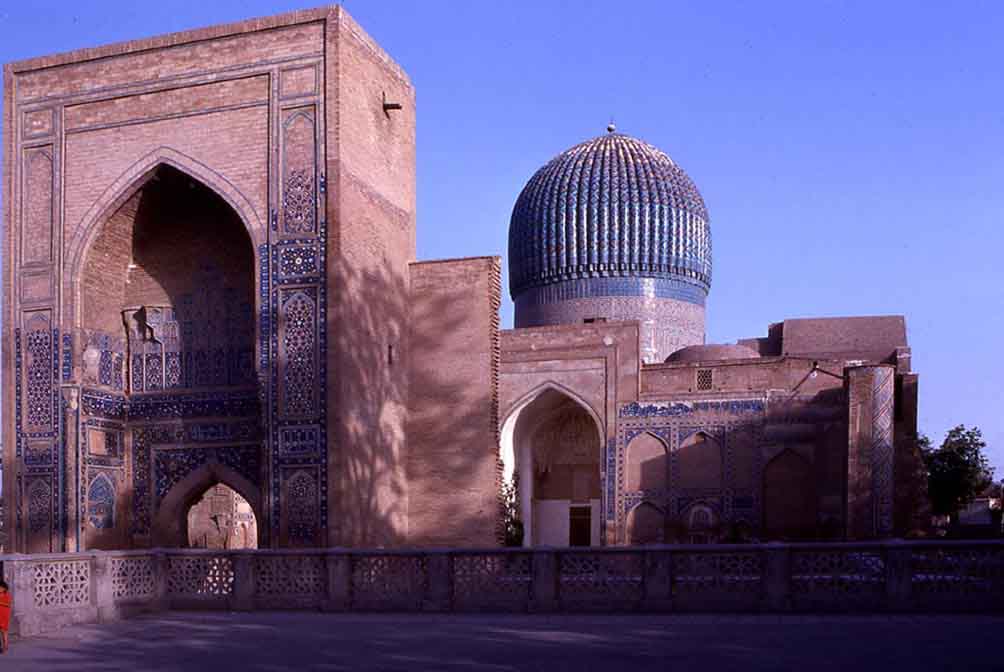
The unique dome after restoration in the 1970s.
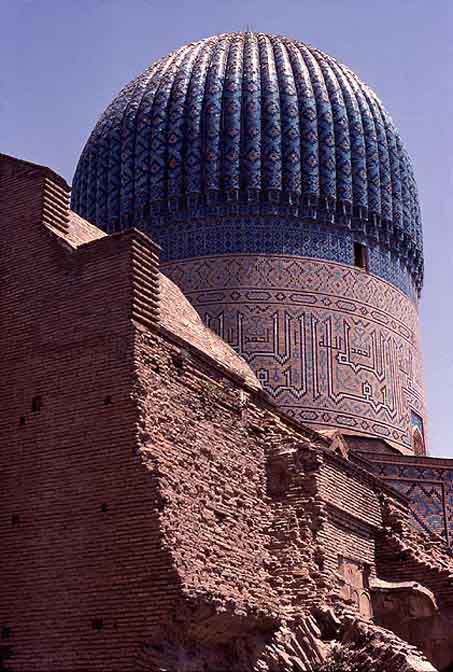
For more photos from Samarkand go to Rolf's Samarkand 1977 and 1989
Más sobre Samarkand Gur-e-Amir Mosque 1403-1404
130: Smarkand Ulugh Begh Medresa 1417-1421
Samarkand, Uzbekistan
Registran
Ulugh Begh Medresa
1417-1421
The oldest madrasa on the north side of the Registran and a khanaqah both of which Ulugh Beg, Timur's grandson and Governor of Samarkand, built facing each other across the square, were part of a large urban project incorporating several mosques, caravanserais and a bazaar. Of this project only the monumental madrasa survives. Oon the site of the khanaqah now stands the 17th-century Shir Dor Madrasa.
During Soviet times and my vists the medresa was for 25 years in reconstruction, and I have no photos better than this one .

Text and photo Archnet.org
Más sobre Smarkand Ulugh Begh Medresa 1417-1421
131: Samarkand Sir Dor Madresa 1619-1636
Samarkand, Uzbekistan
Registran
Sir Dor Madresa
1619-1636
Architects Abdul Jabbar and Mohammad Abbas
Shaybanid
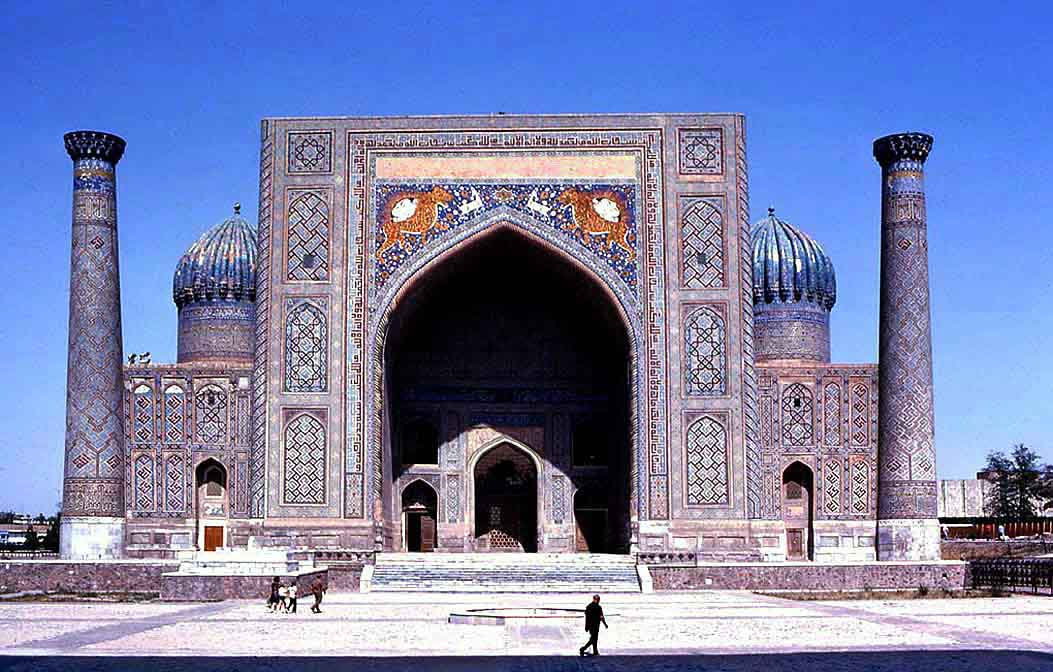
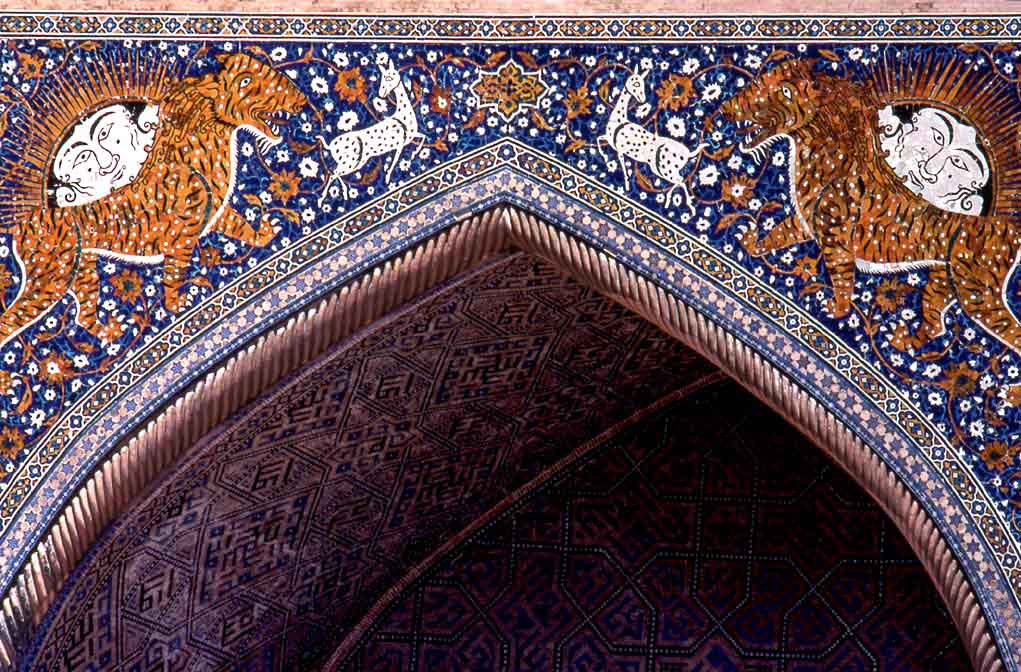
For more photos from Samarkand go to Rolf's Samarkand 1977 and 1989
Más sobre Samarkand Sir Dor Madresa 1619-1636
132: Samarkand Tilla Kari Madresa 1646-1660
Samarkand, Uzbekistan
Registran
Tilla Kari Madresa
1646-1660
Shaybanid
The Tilla Kari madrasa was commissioned a decade after the adjacent Shir Dor madrasa (1619-1636) by the same patron, Shaybanid feudal general, Alchin Yalantush Bahadur between 1646-60. Once part of the complex built by Timur's wife, Tuman-Aka in the fourteenth century, the site had housed the Mirzoi caravan sarai. Built originally as a theological seminary, the Tilla Kari madrasa with its large prayer hall became Samarkand's congregational mosque after the collapse of the Bibi Khanum and the dismantling of Alikeh Kukeltash Mosques.
The medresa was extensively restored in Soviet times before 1990 including the chamber underneath the dome. Photos Rolf Gross 1977 and 1989
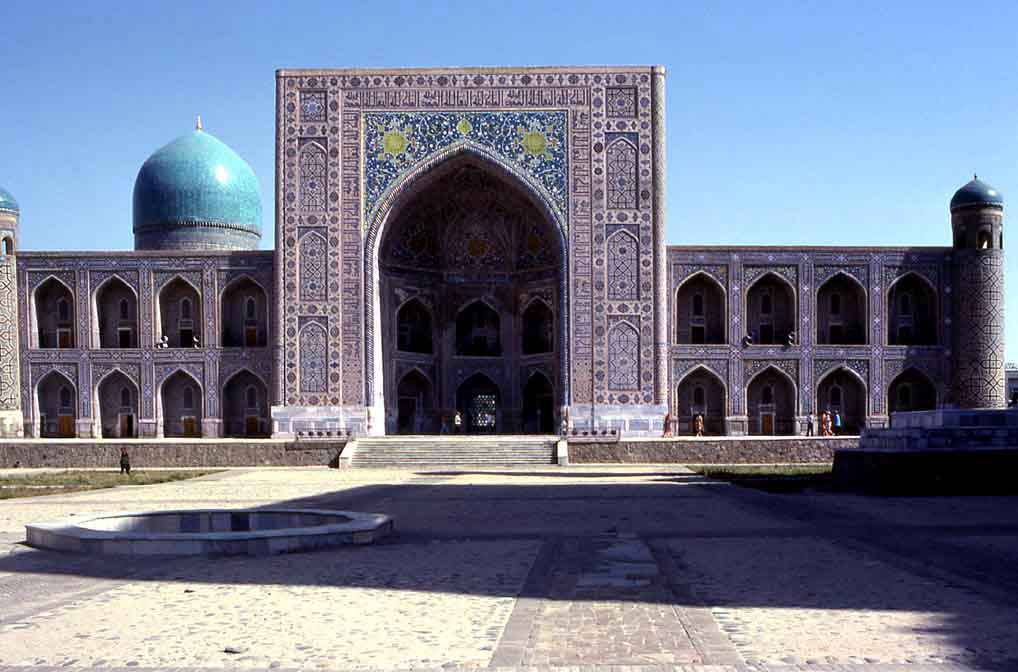
The tiled entry ivan.
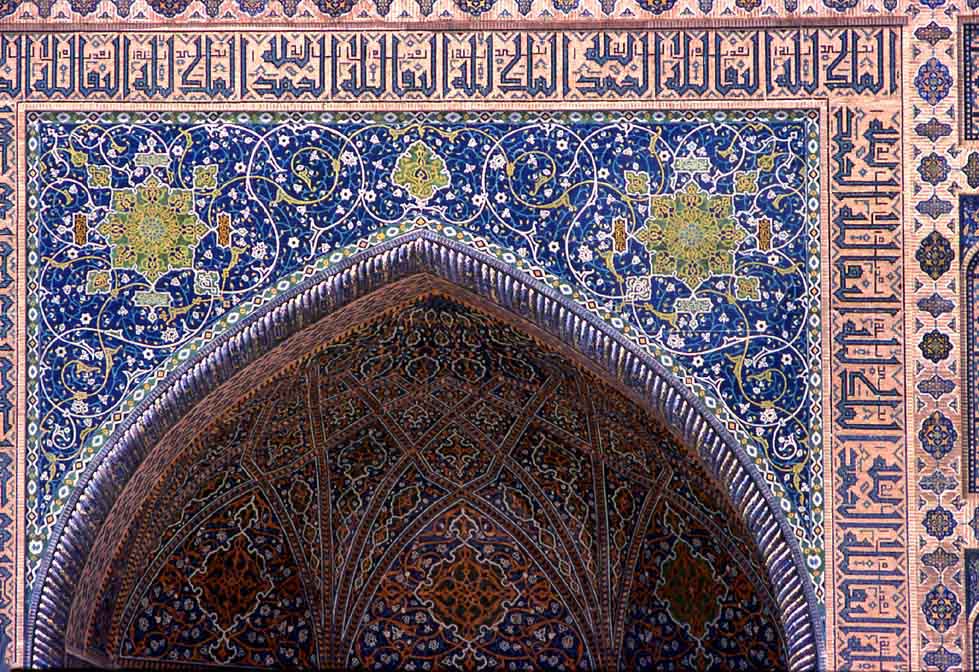
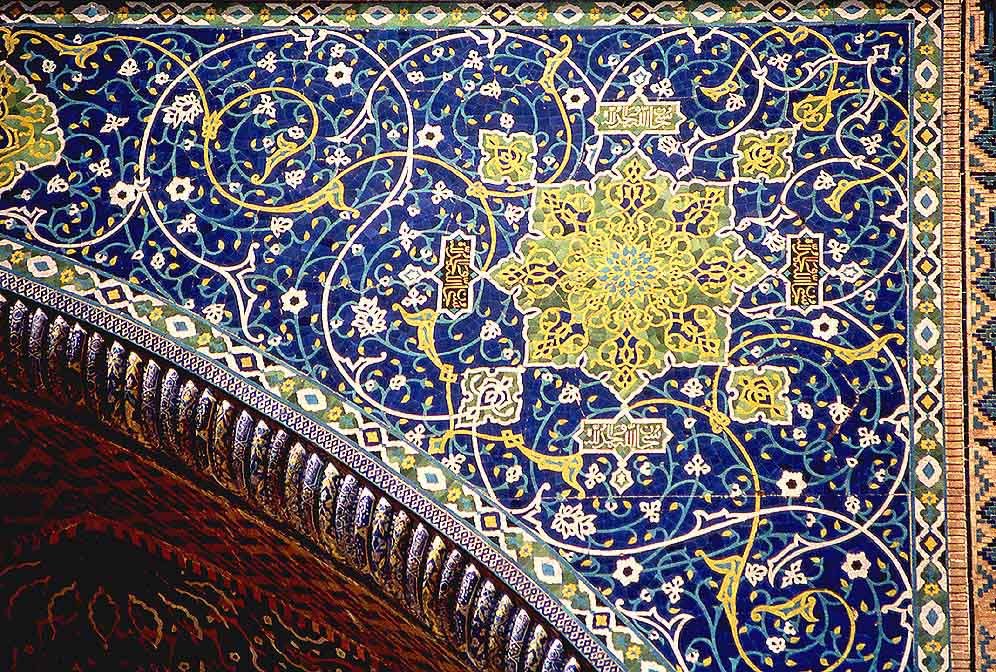
Restored interior tromp l'oeil painting of the non-spherical dome.
Photo from Archnet.org

For more photos from Samarkand go to Rolf's Samarkand 1977 and 1989
Más sobre Samarkand Tilla Kari Madresa 1646-1660
133: Samarkand Shakh-i-Zinda Timurid Mausoleums 11- 15th cent
Samarkand, Uzbekistan
Shakh-i-Zinda
Timurid Mausolea
11- 15th cent
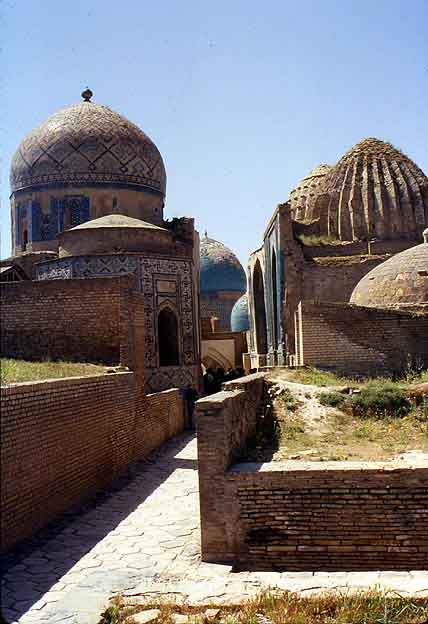
Insrcription over an entry door
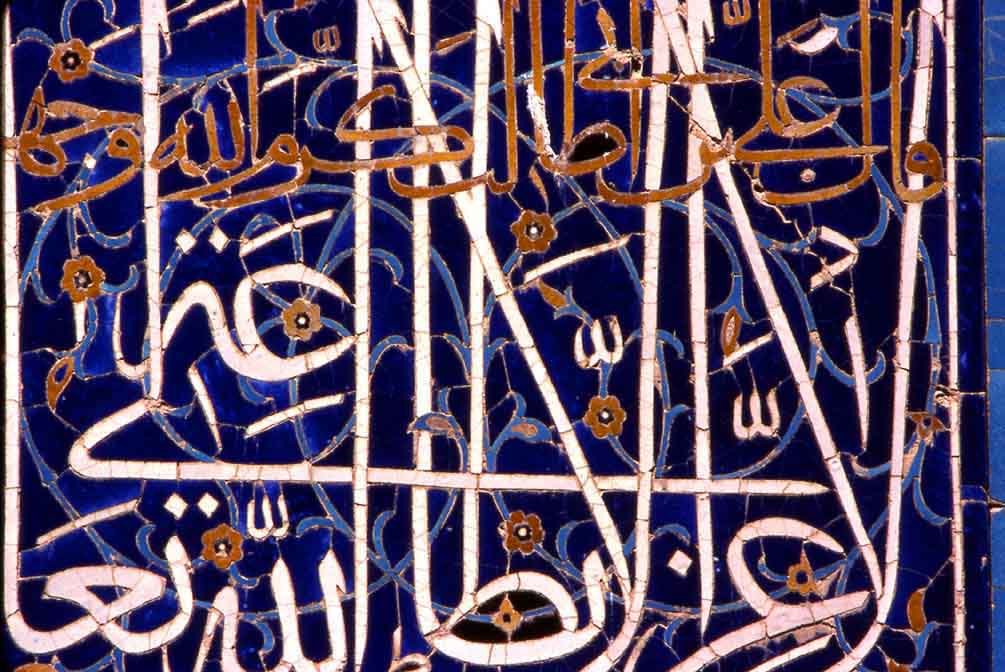
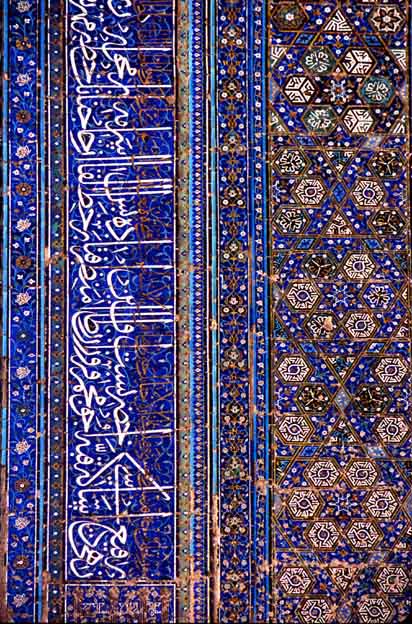
For more photos from Samarkand go to Rolf's Samarkand
Más sobre Samarkand Shakh-i-Zinda Timurid Mausoleums 11- 15th cent
134: Shakh-i-Zabz Aq Serai 1400
Shakh-i-Zabz, Uzbekistan
Timur's Aq Serai Palace
The entry ivan (gate)
around 1400
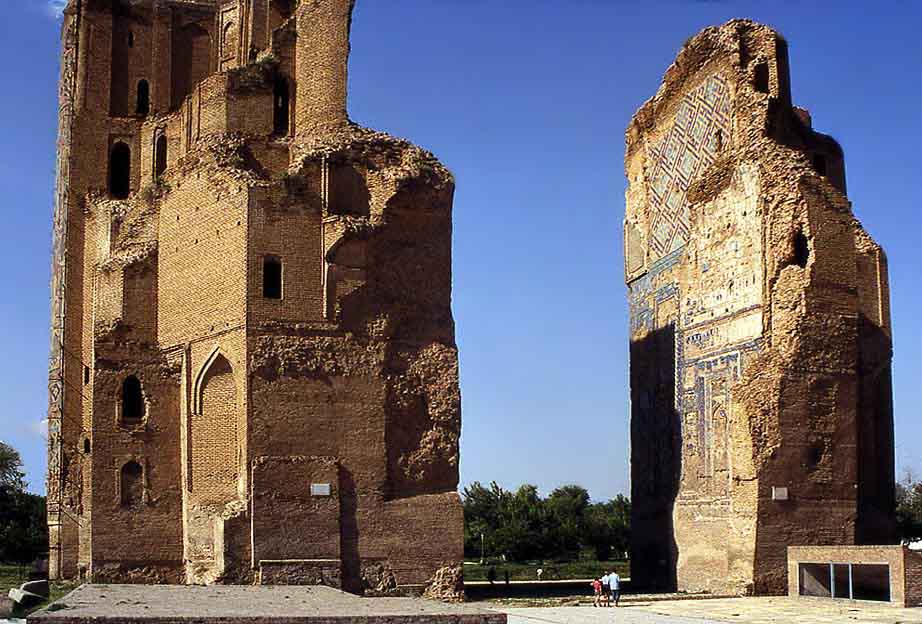
A few surviving large tile mosaics give a small idea of the sophisticated spendor of this palace.
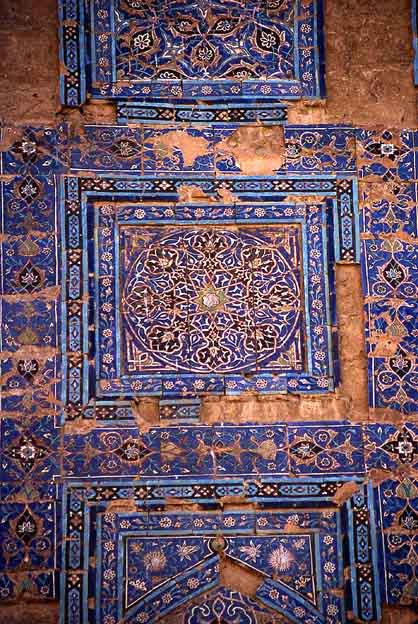
For more photos from Samarkand and Shakh-i-Zabz go to Rolf's Samarkand
Más sobre Shakh-i-Zabz Aq Serai 1400
135: Bukhara, Ulubegh Medresa 1417-21
Bukhara, Uzbekistan
Ulubegh Medresa
1417-21
Timurid
A photo 1925
Text and photo Archnet.org

Más sobre Bukhara, Ulubegh Medresa 1417-21
136: Bukhara, Masjid-i Jami or Kalyan Masjid 1514
Bulhara, Uzbekistan
Masjid-i Jami or Kalyan Masjid
early 14th cent., 1514
Timurid, Shaybanid
Hazarbaf brickwork predominates, with hexagonal haft-rangi floral tiles in the spandrels.

Photo by yves75, Panoramio
Más sobre Bukhara, Masjid-i Jami or Kalyan Masjid 1514
137: Bukhara, Mir-i-Arab Medresa 1535-36
Bukhara
Medresa Mir-i-Arab
1535-36
One copula covers a mosque, the other a karnaka (hospital).

Photo by yves75, Panoramio
Más sobre Bukhara, Mir-i-Arab Medresa 1535-36
138: Bukhara, Kukeltash Medressa 1568-69
Bukhara, Uzbekistan
Kukeltash Medressa
1568-69
Shaybanid

Photo Archnet.org
Más sobre Bukhara, Kukeltash Medressa 1568-69
139: Bukhara, Char-Minar Mosque 1589
Bukhara
Char-Minar Mosque ("Four Minarets")
1589
Shaybanid

Más sobre Bukhara, Char-Minar Mosque 1589
140: Bulhara, Abdulla Khan Mosque and Medresa 1588-90
Bulhara, Uzbekistan
Abdulla Khan Mosque and Medresa
1588-90
Shaybanid
Built during Bukhara's third and last great construction phase when numerous civic structures such as caravanserais, tims (markets), taks (domed market kiosks), hauz (lakes) and khanqahs (hospices). It is noted for its mastery of architectural form, plan and structure at a period of declining trade, political stability and lack of architectural innovation.
Russian archaeological teams extensively restored the madrasa's exterior tile work in the 1950s. The volute arch and dado of the pishtaq display intricate floral patterns in majolica and are fine examples of contemporary workmanship. Text from Archnet.org

Photo by perinic, Panoramio
Más sobre Bulhara, Abdulla Khan Mosque and Medresa 1588-90
141: Bukhara, Divan Begh Medresa 1622-1623
Bukhara, Uzbekistan
Divan Begh Medresa
1622-1623
Janid

Photo by msotomayor Panoramio
Más sobre Bukhara, Divan Begh Medresa 1622-1623
142: Bolo Hauz Mosque 1712
Bukhara, Uzbekistan
Bala-Hauz Masjid (Bolo Hauz Mosque)
1712
Janid
The Bala Hauz Masjid is noted for the profuse colors and carvings on the wooden columns of its porch and its ceiling. The joinery of its painted ceiling features extraordinary craftsmanship with the use of suspended weights, semi-circular arches and balusters.
The important mosque lies in disrepair today, despite considerable tourist interest. The porch is threatened by water damage while its front minaret tilts precariously despite repair attempts. The pool is not dredged or cleaned, and the public toilet adjacent to the mosque adds to its squalor.


Text and photos Archnet.org
Más sobre Bolo Hauz Mosque 1712
143: Emir Han 1338
Bey or Emir Hani
1338
Ottoman
The Bey (or Emir) Hani, one of the oldest inns in Bursa, is part of the Orhan Camii Complex. It has badly suffered from earthquake, fire and restoration. Originally it was very grand, forty-five meters to fifty meters in dimension with a stable at the rear. The stable was demolished in the 15th century to make room for the second minaret of the Ulu Cami. The han as it appears today was restored in 1959 to 1965 after a major fire that destroyed the neighborhood. It is composed of a total of seventy-four cells on two floors with gallery around a large courtyard with hexagonal basin at its center. The construction is brick and cut stone.
Text from Archnet.org
Más sobre Emir Han 1338
144: Orhan Mosque 1339
Orhan Gazi Complex
1339
Ottoman

Text and photo fromArchnet.org
Más sobre Orhan Mosque 1339
145: Orhan Hamami 14th cent
Orhan Gazi Complex
Orhan Hamami
14th cent
Ottoman
Text from Archnet.org
Más sobre Orhan Hamami 14th cent
146: Bursa Sultan Emiir Camii 13th cent
Bursa
Sultan Emiir Camii
Built for Sultan Selim II
13th cent. Rebuilt in 1804. Photo Rolf Gross, 1990
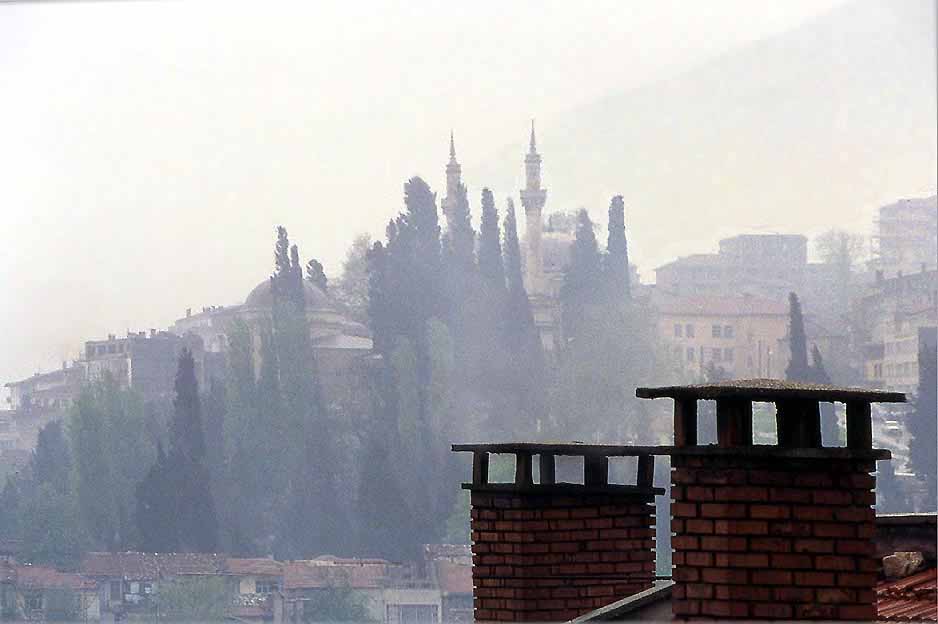
Más sobre Bursa Sultan Emiir Camii 13th cent
147: Bursa Hüdavendigar Külliye 1365-1385
Bursa
Hüdavendigar Külliyesi
Murat I Complex
1365-1385
The mausoleum was commissioned by Bayezid I after the death of his father Murad I in Kosovo in 1329 and is located to the south of the mosque. It is a single-unit with a dome resting on double arches and Byzantine columns and houses the tombs of Murad I and seven other members of the Ottoman family.
View of the northern façade of the mosque with five-bay portico and gallery above

Text and photo Archnet.org
Más sobre Bursa Hüdavendigar Külliye 1365-1385
148: Bursa Yildirim Beyazit I Medresa 1394
Bursa
Yildirim Beyazit I Medresa and Tomb 1394
Architect Hüseyin bin Ali
General view from northwest, showing madrasa in front of the mosque

Exterior view of the mausoleum from southwest, with pishtak portal of madrasa visible on lower left

Detail from entrance to mausoleum showing inscriptive plaque (kitabe) in Arabic with nesih characters, announcing patronage of Suleyman Celebi and the name of architect Huseyin bin Ali, with the date of construction 1394 (809 A.H).

Plan of complex

Floor plan of complex showing (1) gate, (2) mausoleum, (3) madrasa, (4) site of royal garden palace, (5) convent-masjid, (6) hospice, (7) bathhouse, (8) gate, (9) reconstruction of precinct wall, (10) aqueduct
Text and images Archnet.org
Más sobre Bursa Yildirim Beyazit I Medresa 1394
149: Bursa Ulu Cami 1396 - 1400
Bursa
Ulu Cami
1396 - 1400
View of the southern fa�§ade and the roof with its twenty domes, with the Atat�¼rk street in front and the Bursa plains in the distance. Photo from Archnet.org

Interior after Friday services (Photo Rolf Gross, 1990)
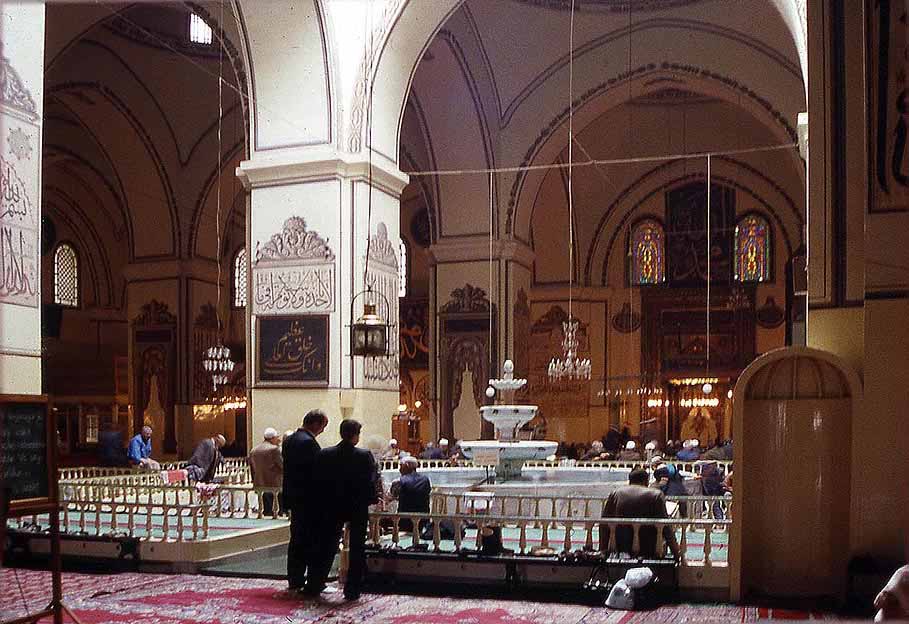
Más sobre Bursa Ulu Cami 1396 - 1400
150: Bursa Muradiye 1426-1428
Bursa
Muradiye
Murad II's Tomb and Külliye
1426-1428

Text anf photo Archnet.org
This is one of the most peaceful places in Bursa (Photo Rolf Gross, 1990)
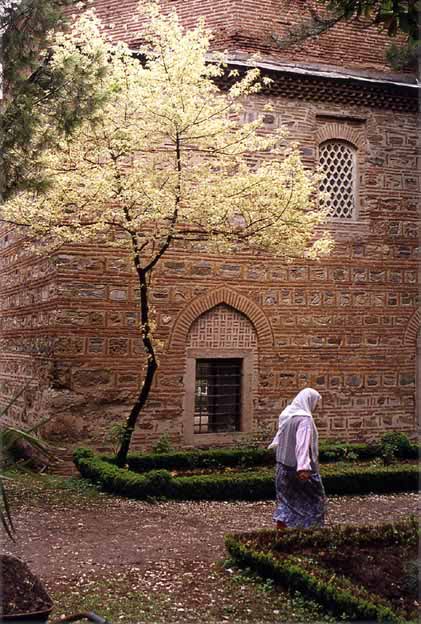
Más sobre Bursa Muradiye 1426-1428
151: Koza Han 1481-1512
Koza Han
1481-1512
Ottoman
The Koza (Cocoon) Han was commissioned by Bayezid II and built in 1481-1512 in the market neighborhood between Ulu Cami and Orhaniye, to provide income for the sultan's mosque in Istanbul. Functionally it is part of the Orhan Complex.

Text from Archnet.org
Más sobre Koza Han 1481-1512
152: Bursa Yesil Cami Mosque of Mehmed I 1491-1421
Bursa
Mosque of Mehmed I - Yesil Camii "Green Mosque"
1419-1421
Architect Haci Ivaz Pasa

Photo Archnet.org
Más sobre Bursa Yesil Cami Mosque of Mehmed I 1491-1421
153: Bursa Yesil Türbe Mehmed I Tomb 1419-1421
Bursa
Yesil Türbe
Mehmed !'s Tomb
1419-1421
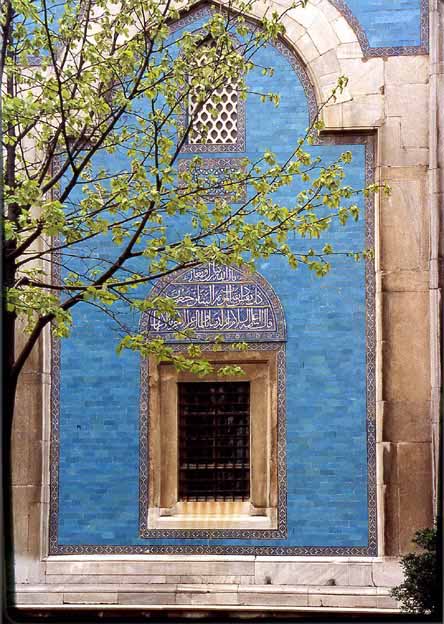
Más sobre Bursa Yesil Türbe Mehmed I Tomb 1419-1421
154: Didymotikhon Ã?elebi Sultan Mehmet Mosque 1420-1421
Didymotikho, GreeceÃ?elebi Mehmet Mosque - Bayezid Camii
1420 - 1421
Ottoman
Architect Ivaz Pasa
The mosque was built in 1420 by Sultan Mehmed II. In the Greek archives the mosque is named Bayezid Camii.
The mosque - without a dome - may be unfinished: Like the Green Mosque in Bursa -- another mosque built by Ivaz Pasa under Mehmet II -- was also left incomplete with the Sultan's death in 1421.

Text and photo Archnet.org
Más sobre Didymotikhon Ã?elebi Sultan Mehmet Mosque 1420-1421
155: Edirne Eski Camii 1402-14
Edirne
Eski Camii - Old Mosque
1402-14
Architect Haci Alaeddin of Konya
The construction of the Old Mosque of Edirne began in 1402 by Emir S�¼leyman and was completed under the rule of his brother Mehmed I in 1414. Built as a Friday Mosque in the market neighborhood of Edirne, the mosque took on its current name following the completion of the new �ç Serefeli Mosque in 1447. The mosque was restored between 1924 and 1934 and in 1965 after the 1953 earthquake.

The Prophet's Name (peace be upon him) etched adjacent to a window on the northern façade (19th cent)

The interior of the mosque is a low heavy space, an excellent example of pre-Sinan architecture. If is adorned with painted decoration and large calligraphy dating from the second half of the 19th century. The stone mihrab and minbar remain despite damage by fire. The mihrab is unique with small muqarnas niches placed inside the primary niche.

Text and Photographs from Archnet.org
Más sobre Edirne Eski Camii 1402-14
156: Edirne Muradiye 1435
Edirne
Muradiye
1435
.

Exterior detail showing carved wooden door and inscriptive plaque in Arabic giving the name of the donor and date of completion.

Text and photographs from Archnet.org
Más sobre Edirne Muradiye 1435
157: Edirne �ç Serefeli Mosque and Külleyi 1437 - 1447
Edirne
Uc Serefeli Mosque and K�¼lleyi
1437 - 1447

Inner courtyard with typical colored masonry inserts

Exterior detail from portico, showing tiled tympanum of window with prayers in Arabic mentioning the founder of the mosque. Here the masonry is painted on.

Text and photos Archnet.org
Más sobre Edirne Ã?ç Serefeli Mosque and Külleyi 1437 - 1447
158: Edirne Beyazit II Külliye 1484-1488
Edirne
Beyazit II Külliye
1484-1488

Plan of the külliye:

Floor plan of complex along the Tunca river, showing (1) mosque, (2) hospice, (3) caravanserai, (4) hospital, (5) madrasa, (6) site of bathhouse
Text and images from Archnet.org
Más sobre Edirne Beyazit II Külliye 1484-1488
159: Aghia Eirene 548
Constantinople-Istanbul
Aghia Eirene
Originally built by Emperor Justinian I, 4th cent
Present building: 548
After the conquest of Constantinople in 1453 the church was converted into an armoury. It was restored by Field Marshall Ahmed Fethi PaÃ?Â?a in 1846 and became the first Turkish museum. It was used as a Military Museum from 1908 until 1978. Today, it serves mainly as a concert hall for classical music performances, due to its extraordinary acoustic characteristics and impressive atmosphere.

The cross in the main apse is a unique example of theIslam-inspired Iconoclast period in Byzantine art (730-787).

Text and photos from Wkipedia
Más sobre Aghia Eirene 548
160: Church of Sts. Sergius and Bacchus - Küçük Ayasofia ~530
Constantinople-Istanbul
Monastery of the Sts. Sergius and Bacchus - Küçük Ayasofia Camii (Little Aghia Sofia)
Built by Justinian I
~530
The church of Sts. Peter and Paul was demolished during the construction of a raiload in the 1860s.
H�¼seyin Aga, the chief officer of the Ottoman Palace during the rule of Bayezid II (1481-1512), converted the Church of Sergius and Bacchus into a mosque. The mosque has a single minaret on the southwest corner, which dates from 1955. The K�¼�§�¼k Ayasofya was included in the annual list of the World Monuments Watch as one of the "100 Most Endangered Sites" in 2002. -

Photo before 1955 - without minaret.

Interior, photo early 20th cent.

Text and photos from Archnet.org
Más sobre Church of Sts. Sergius and Bacchus - Küçük Ayasofia ~530
161: Aghia Sophia 532 - 537
Constantinople-Istanbul
Aghia Sofia
Built by Emperor Justinian I
Present building: 532-537
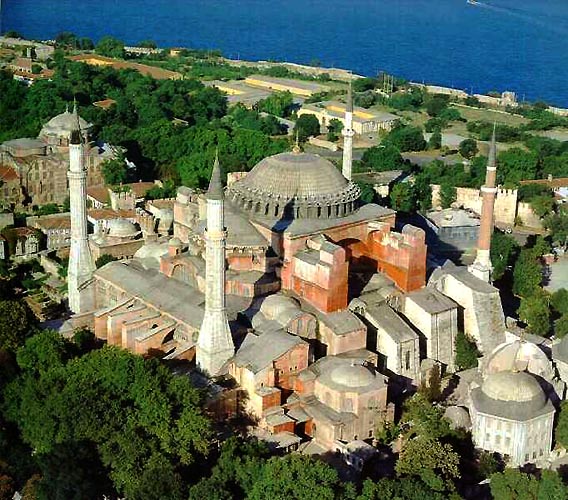
Photo from Wikipeda, Hagia Sofia
Cross section of the building

Floor Plan: from Wikipedia
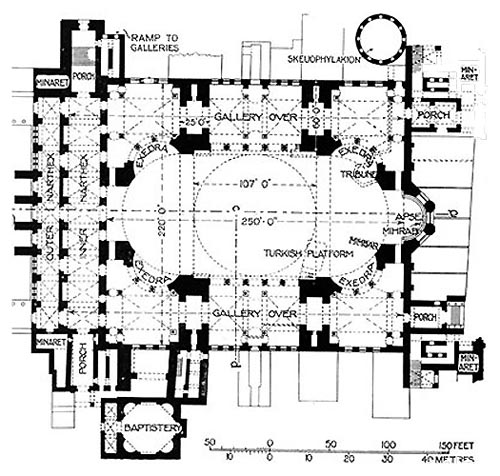
It is virtually impossible to photograph the enterior without a specialized camera . This photograph - the only one I could find - is from 1890 before the mosque was converted into a museum (Harvard Archives):

Photo Archnet.org
My own attempt (1990). The marble urn is from Bergama and was placed here by Selim III (1566-1574)
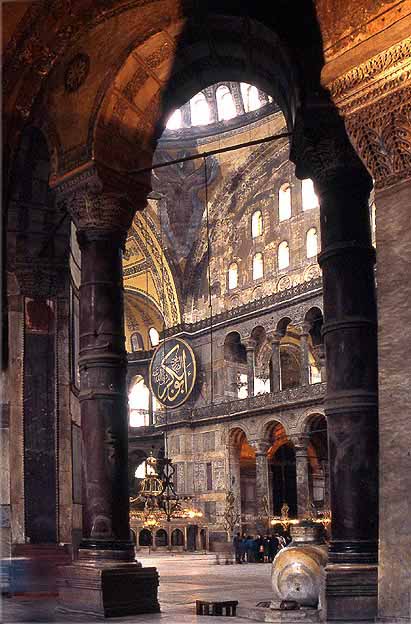
Sultan Ahmed Mosque seen from a window of the women's gallery in the Aghia Sofia (1990).

Más sobre Aghia Sophia 532 - 537
162: Pammakaristos Church - Fetiyeh Cami 11/12th cent
Constantinople-Istanbul
Church of the Monastery of Pammakaristos - Fetiyeh Camii
11th or 12th cent

Text and photo Archnet.org
Few churches in Constantinople have had an as varied history as the Pammakaristos. The Pammakaristos church was converted into Fethiye Cami or "Victory Mosque" in 1591 by Murad III to commemorate his conquest of Georgia and Azerbaijan. The Greek Orthodox Patriarchy, who had taken refuge in the Pammakaristos at the time of the Ottoman conquest, was transferred to its current location in Fener in the year of its conversion into a mosque.
The fire of Balatkapi damaged the mosque in 1640. It was repaired in 1845, and finally restored in 1936-38. Abandoned after the restoration, the main space was re-opened to Islamic prayer only in 1960. The parekklesion, restored to its pre-Ottoman state by the Byzantine Institute of America, is now open to visitors as a museum. The obove photo shows mainly the parekklision with its copulas.
Más sobre Pammakaristos Church - Fetiyeh Cami 11/12th cent
163: Chora-Kariye Ekkllesia 11th cent
Constantinople-Istanbul
Chora Ekkllesia - Kariye Camii
Present building: 11th cent

Text and photo from Archnet.org
Restored after an earthquake in 557, the basilica was rebuilt in its current Greek-cross plan in the 11th century. Additions and renovations (1316-1321) were sponsored by Theodore Metochites, a scholar and prime minister under Andronicus II. One of the last churches built before the Fall of Constantinople (1453).
Its importance does not lie as much with its architecture but in the mosaics and frescoes which grace its interior and that of the attached parekklesion.
After it was declared a museum, the Byzantine Institute of Washington D.C. and the Dumbarton Oaks Center of Byzantine Studies restord it in 1948.
My free-hand photographs (before digital cameras) of the mosaics of the vault of the main church (1990)
.
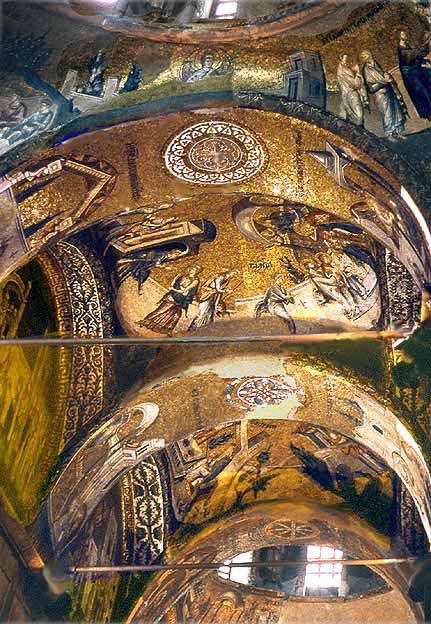
and the frescoes of the Parekklision (1990)
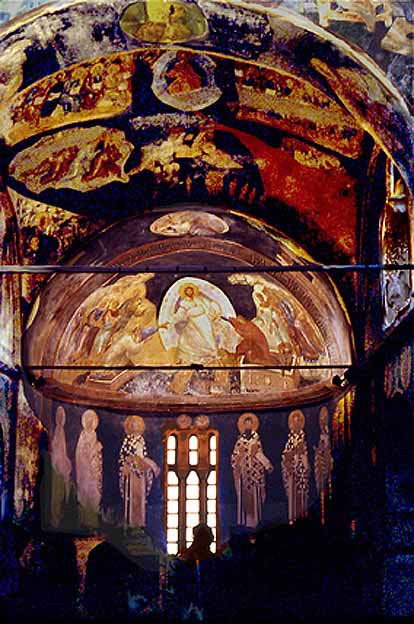
Más sobre Chora-Kariye Ekkllesia 11th cent
164: Pantocrator Church -Zeyrek Camii
Constantinople-Istanbul
Pantocrator Church -Zeyrek Camii
1118-1143

Photo Wikipedia
The main trakt, used as mosque is in poor, the right parakklision in better condition.
Más sobre Pantocrator Church -Zeyrek Camii
165: Christ Pantepoptes Eski Imaret Mosque 11 cent
Constantinople-Istanbul
Christ Pantepoptes - Eski Imaret Mosque
11th century
Eski Imaret Mosque was a Byzantine church dedicated to Christ Pantepoptes, "Christ the all-seeing". It is the only documented 11th century church in Istanbul which survived intact, and represents a key monument of middle Byzantine architecture. Despite that, the building remains one of the least studied churches in the city. From Byzantine Churches of Istanbul

Más sobre Christ Pantepoptes Eski Imaret Mosque 11 cent
166: Aghios Theodoros - Vefa Kilise or Molla Ã?elebi Camii 11th cent
Constantinople-Istanbul
Aghios Theodoros - Vefa Kilise or Molla Ã?elebi Camii
11th century
From Byzantine Churches of Istanbul, nyu.edu

Más sobre Aghios Theodoros - Vefa Kilise or Molla Ã?elebi Camii 11th cent
167: Eyyüb Mehmet Sultan Mosque 1458
Istanbul-Eyyüb
Mehmet Sultan Complex
1458
The mosque was first built in 1458 by Mehmet the Conqueror on the site where Ebu Eyyüb el Ensari, who was Mohammed's standard-bearer, was killed under the walls of Constantinople during the first siege by the Arabs (672-677). His tomb, in the walls surrounding the mosque, has beautiful �°znik tiles. The mosque was reconstructed by Sultan Selim III between 1798-1800. It is of no particular architectural interest - but large numbers of pilgrims visit the tomb of Gazi el Ensari. It is also a favorite place for circumcision ceremonies of young boys.
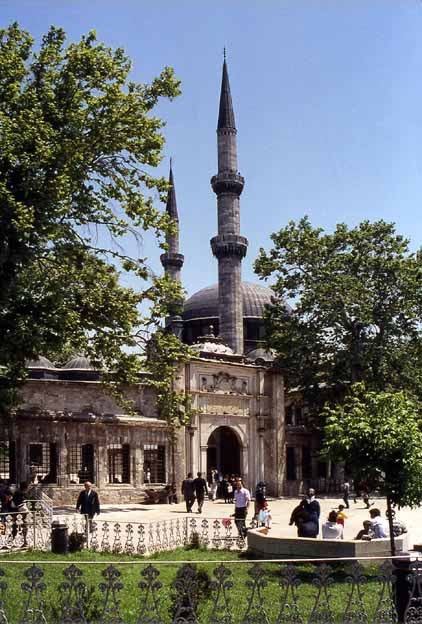
Photo Rolf Gross 1990
Más sobre Eyyüb Mehmet Sultan Mosque 1458
168: Fatih Mehmet the Conqueror.Camii 1462-1470
Istanbul
Fatih Mehmet the Conqueror.Camii
1462-1470, 1771, interior restored 2000
Architect Atik Sinan (Old Sinan), reconstructed by head-architect Mehmed Tahir
The Fatih Mosque is the sanctuary of the imperial complex built by Mehmed II to commemorate his conquest of Constantinople in 1453. It stands at the center of an extended precinct that was entered through gates along the northern and southern walls. It was intended to be a center of learning and is flanked by 16 medreses to the east and the west, which were the first Ottoman educational institutions in Istanbul. Education was no longer based on religious studies only, but now included the rational sciences such as mathematics, astronomy and philosophy . The architect of the mosque and the complex,was Atik Sinan (Old Sinan). Built between 1463 and 1470. Tthe complex was severely damaged during an earthquake in 1766. On Mustafa III's behest the mosque was demolished and rebuilt by Mehmed Tahir (1771) in the Baroque style.
The mosque is currently under restoration to repair damage caused by the earthquake of 1999.

Text and photo Archnet.org

Photo by Dick Osseman
Más sobre Fatih Mehmet the Conqueror.Camii 1462-1470
169: Bayezit II Camii and Külliye 1501-1505
Istanbul
Beyazit II Camii and Külliye
Architect Mimar Hayreddin or Yakupsah bin Sultansah
1501-1505

The mosque's dome was partially rebuilt after the 1509 earthquake, and Mimar Sinan conducted repairs in 1573-74. The structure of the Bayezid mosque is considered a stepping stone between early Ottoman architecture and classical Ottoman architecture, characterized by a central dome held by semi-domes on all four sides.
Plan of the complex


The courtyard

Interior: main dome and two side halfdomes

Photos and Text from Archnet.org
Más sobre Bayezit II Camii and Külliye 1501-1505
170: Bali Pasha Mosque 1504-1505
Istanbul
Bali Pasha Mosque
1504-1505
The mosque was built on commission by Bali Pasha and his wife, Hüma Hatün.

Floor Plan and elevation from Archnet.org

Más sobre Bali Pasha Mosque 1504-1505
171: Yavuz Sultan Selim I Mosque 1519-1522
Istanbul
Yavuz Sultan Selim I Mosque
1519-1522
Architect: Alauddin

Muquarnas (staliktites) above the entrance to the mosque

Detail of a column supporting the courtyard porch

Text and photos from Archnet.org
Más sobre Yavuz Sultan Selim I Mosque 1519-1522
172: Edirne Rüstem Pasha Caravanseray 16th cent
Edirne
Rüstem Pasha Caravanseray
16th cent, restored 1972
Arichitect Minmar Sinan

Isometric plan

View from the restored rooftops onto Sinan's Selimiye mosque. The domes of the caravanseray were completely reconstructed with concrete and supported by concrete beams

Text and photos fromArchnet.org
Más sobre Edirne Rüstem Pasha Caravanseray 16th cent
173: Edirne Selimiye Camii Edirne 1567-74
Edirne
Selimiye Camii 1567-74
Architect: Mimar Sinan
The mosque was commissioned by Sultan Selim II and was built by architect Mimar Sinan between 1568 and 1574. Sinan considered it his masterpiece. It is one of the highest achievements of Islamic architecture.
Photos by Dick Osseman



Isometric drawing

Text and isometric drawing from Archnet.org
Más sobre Edirne Selimiye Camii Edirne 1567-74
174: Haseki Hürrem Sultan Mosque and Külliye 1538-1539
Istanbul
Haseki Hürrem Sultan Mosque and Külliye 1538-1539
Architect Mimar Sinan

View of the painted dome and the squinches at its corners.

Isometric dawing and photos Archnet.orgi
Más sobre Haseki Hürrem Sultan Mosque and Külliye 1538-1539
175: Barbarossa Hayrettin Pasha Türbe 1541
Istanbul
Barbarossa Hayrettin Pasha Tomb 1541
Architect Mimar Sinan

(Photo and text modified from Evliya, GE-BBS)
Más sobre Barbarossa Hayrettin Pasha Türbe 1541
176: Sehzade Mosque and Külliye 1543 - 1548
Istanbul
Sehzade Mosque and Külliye 1543 - 1548
Architect: Mimar Sinan
Sultan Süleyman the Magnificent commissioned the mosque in memory of his beloved son, Prince Mehmet. The Sehzade Külliye, which was completed before the mosque itself, was made up of the Tomb of Sehzade Mehmed, a theology school, a soup kitchen and a printing house. (
Old etching of the Sehzade Mosque. From Caltech.edu


Image and text adapted from Evliya, GE-BBS
Más sobre Sehzade Mosque and Külliye 1543 - 1548
177: Mihrimah Mosque (Iskele) 1547-1548
Istanbul-�sküdar
Mihrimah Mosque (Iskele) 1547-1548
Architect Mimar Sinan
Next to a beautiful fountain and the ferry dock. The first of two mosques built for Mihrimah, the daughter of Sultan Süleyman and wife of Rüstem Pasa. (Text modified from Evliya, GE-BBS)
Isometric drawing of the Külliye.
Drawing and photo from Archnet.org)

And the �sküdara fountain

Photo by emreander, Panoramio
Más sobre Mihrimah Mosque (Iskele) 1547-1548
178: Sülemaniye Mosque and Külliye 1551-1558
Istanbul
Sülemaniye Camii and Külliye
1551- 1558
Architect Mimar Sinan
Sinan's Sülemaniye was intended to be the architectural answer to Justinian's Hagia Sophia, which had already served as a model for many other Ottoman mosques in Istanbul. Sinan's Sulimaniye surpasses in rational symmetry, and light-filled space all earlier Ottoman precedents, as well as the Hagia Sophia. It is possible that the dialogue between Istanbul and Italy contributed to Sinan's enthusiasm for symmetrical and rational forms, as promoted by writers like Alberti.
As a self-conscious representation of Süleyman's dream as a 'second Solomon' it also references the Dome of the Rock, built on the site of the Temple of Solomon, as well as Justinian's boast upon the completion of the Hagia Sophia: "Solomon, I have surpassed thee!" The Süleymaniye, similar in magnificence to the preceding structures, asserts Sultan Süleyman's historical importance. The structure is nevertheless smaller in size than its older archetype, the Hagia Sophia. - Following 3 Photos Rolf Gross, 1954/1990.
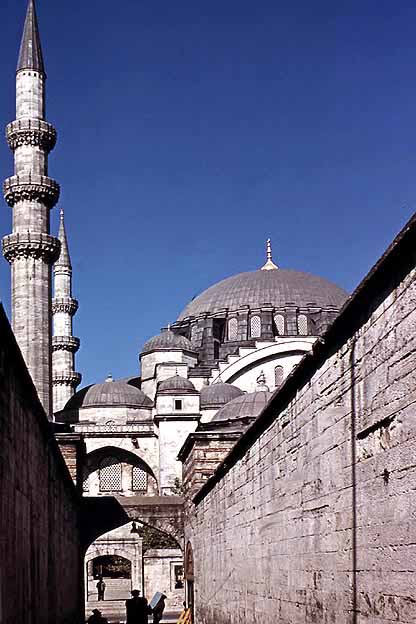
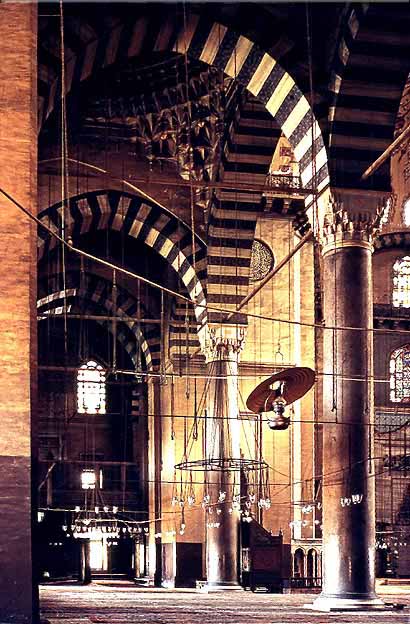
Iznik tiles on the türbe, the tomb of Sultan Süleyman the Magnificent and his wife Haseki Hürrem Sultan in the cemetery of the Süleymaniye. Mimar Sinan is also buried there.
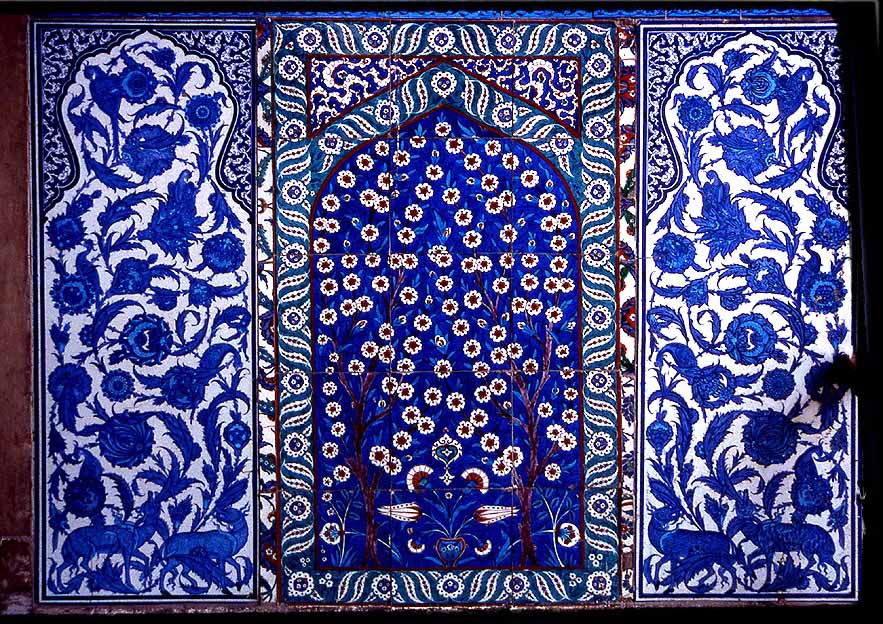


Floor plan of the complex, showing (1) mosque, (2) mausoleum of Süleyman, (3) mausoleum of Hürrem, (4) Koran recitation school, (5) public fountain, (6) elementary school, (7) first (evvel) madrasa, (8) second (sani) madrasa, (9) remains of medical school, (10) hospital, (11) hospice, (12) guesthouse, (13) Sinan's tomb with domed sabil and empty plot of his endowed school and residence, (14) the janissary agha's residence, (15) third (salis) madrasa, (16) fourth (rabi) madrasa, (17) bathhouse, (18) hadith college, (19) madrasa near the palace of Fatma Sultan and Siyavus Pasa.
Text and above plans from Archnet.org
It seems befitting to end this description wirh Tizian's (1530) portrait of Süleyman the Magnificent

From Wikepedia.
Más sobre Sülemaniye Mosque and Külliye 1551-1558
179: Hadim Ibrahim Pasha Mosque 1551
Istanbul
Hadim Ibrahim Pasha Mosque
1551
Architect Mimar Sinan

Interior showing the trompes which integrate the dome and the square base. 
Text and photos from Archnet.org
Más sobre Hadim Ibrahim Pasha Mosque 1551
180: Zal Mahmut Pasha Mosque 1551-1566
Istanbul
Zal Mahmut Pasha Mosque
1551-1566
Architect Mimar Sinan

Isometric Drawing

Isometric Drawing from Archnet.org
Más sobre Zal Mahmut Pasha Mosque 1551-1566
181: Sinan Pasha Mosque 1554-55/56
Istanbul
Sinan Pasha Mosque
1554-55/56
Architect Mimar Sinan

Isometric Drawing 
Photo and drawing Archnet.org
Más sobre Sinan Pasha Mosque 1554-55/56
182: Haseki Hürrem Sultan Hamam 1556
Istanbul
Haseki Hürrem Sultan Hamam (1556)
Architect Mimar Sinan

View of entry from the men's dressing room into the cool room

Entryway with multifoliate crown into the hot room

Photos from Archnet.org
A romantic sunset behind Sinan's hamam, from turkeytravelplanner.com

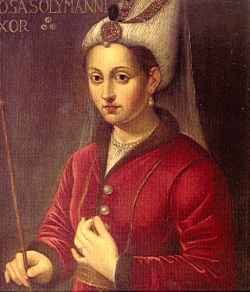
Photo from .atamanhotel.com
Más sobre Haseki Hürrem Sultan Hamam 1556
183: Rüstem Pasha Mosque 1561-63
Istanbul
Rüstem Pasha Mosque 1561-63
Architect Mimar Sinan
<./center>Rüstem Pasha was Sultan Süleyman the Magnificent's Grand Vizier and was married to his prefered daughter, Mihrimah. This little gem of a mosque was built by Sinan. It is covered inside and out with beautiful blue Iznik tiles
The porch. - Photo by Dick Osseman

The tiled interior

The dome


Interior photos and Isometric Drawing from Archnet.org
Más sobre Rüstem Pasha Mosque 1561-63
184: Mihrimah Sultan Mosque Edirnekapi 1563-70
Istanbul-Edirnekapi
Mihrimah Sultan Mosque
1563-70
Architect Mimar Sinan
It is the "Gothic" mosque among Sinan's buildings. The non-bearing walls are broken by several dozens of windows flooding the interior with a profusion of light. The dome seems to be nearly weightlessly suspended on four slender pilasters and 6 collumns, the only weight-bearing supports . There are no outside buttresses. A stunning piece of structural engineering.

Structurally the window walls appear nearly weightless

Tthe same wall from the inside: light everywhere

The seemingly floating dome

Text and photos from Archnet.org
Más sobre Mihrimah Sultan Mosque Edirnekapi 1563-70
185: Kara (Gazi) Ahmed Pasha Mosque 1565-1572
Istanbul
Kara (Gazi) Ahmed Pasha Mosque
1565-1572
Architect Mimar Sinan
Interior view from upper gallery, looking towards qibla wall

Interior view showing mihrab and minbar

Interior detail; painted wooden ceiling of muezzin's platform (müezzin mahfili)
 "
"
Isometric Drawing 
Drawing and photos from Archnet.org
Más sobre Kara (Gazi) Ahmed Pasha Mosque 1565-1572
186: Piyale Pasha Mosque 1565-73
Istanbul
Piyale Pasha Mosque
1565-73
Architect Mimar Sinan

Historical photo from the beginning of the 20th century

It was recently restored, the porch had collapsed. The interior is again charmed by old-fatherly bands of tile inscriptions:

Plan and photos from Archnet.org
Más sobre Piyale Pasha Mosque 1565-73
187: Sokullu Mehmet Pasha Mosque Kardirga 1567-1571
Istanbul- Kadirga
Sokollu Mehmed Pasa Complex
1567-1571
Architect Mimar Sinan
Portico and ablution fountain

The tiled interior:

Blue tiles near the quibla

foundation inscription above northern portal


Plan and photos from Archnet.org
Más sobre Sokullu Mehmet Pasha Mosque Kardirga 1567-1571
188: Sokullu Mehmet Pasha Mosque-Azapkapi 1573-1578
Istanbul
Sokullu Mehmet Pasha Mosque-Azapkapi
1573-1578
Architect Mimar Sinan


Plan and photos from Archnet.org
Más sobre Sokullu Mehmet Pasha Mosque-Azapkapi 1573-1578
189: Sultan Selim II's Tomb 1577
Istanbul
Sultan Selim II's Tomb 1577
Architect Mimar Sinan

Interior view showing the columns supporting the dome structure and sarcophagi belonging to Selim II and his family
Photos from Archnet.org
Más sobre Sultan Selim II's Tomb 1577
190: Atik Valide Mosque and Kulliye 1571-1583
Istanbul-�sküdar
Atik Valide Mosque and Külliye
1571-1583
Architect Mimar Sinan




Plans and photos from Archnet.org
Más sobre Atik Valide Mosque and Kulliye 1571-1583
191: Kiliç Ali Pasha Mosque and Külliye 1578 -1581
Istanbul
Kiliç Ali Pasha Mosque and Külliye
1578-1581
Architect Mimar Sinan

Isometric drawing

Text, photo, and plan from Archnet.org
Más sobre Kiliç Ali Pasha Mosque and Külliye 1578 -1581
192: Semsi Ahmet Pasa Külliyesi 1580-81
Istanbul-�sküdar
Semsi Ahmet Pasa Külliyesi
1580-81
Architect Mimar Sinan

Text and above photo from Archnet.org
Following photos Rolf Gross, 1990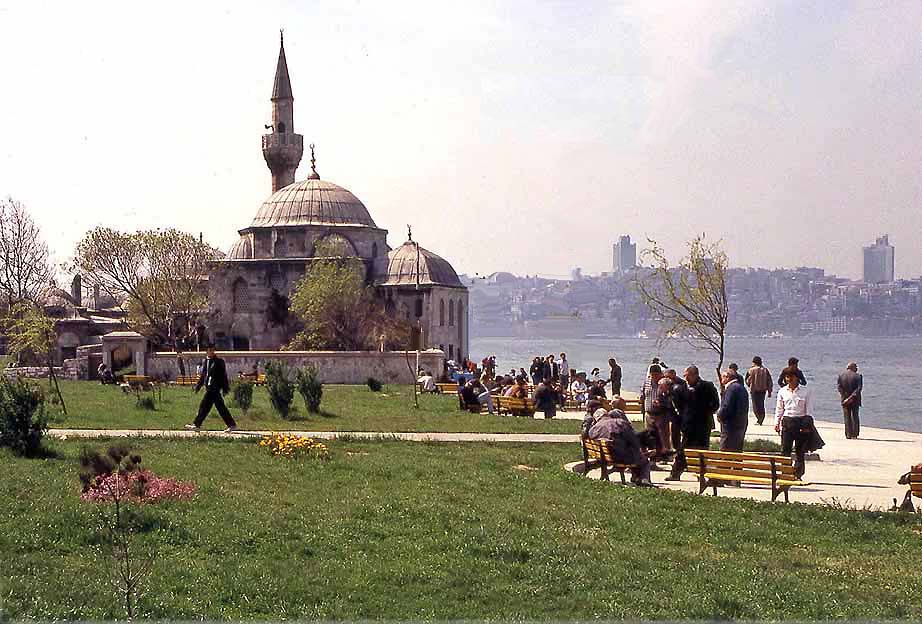
Cemetery of the Semsi Ahmet Pasa Külliye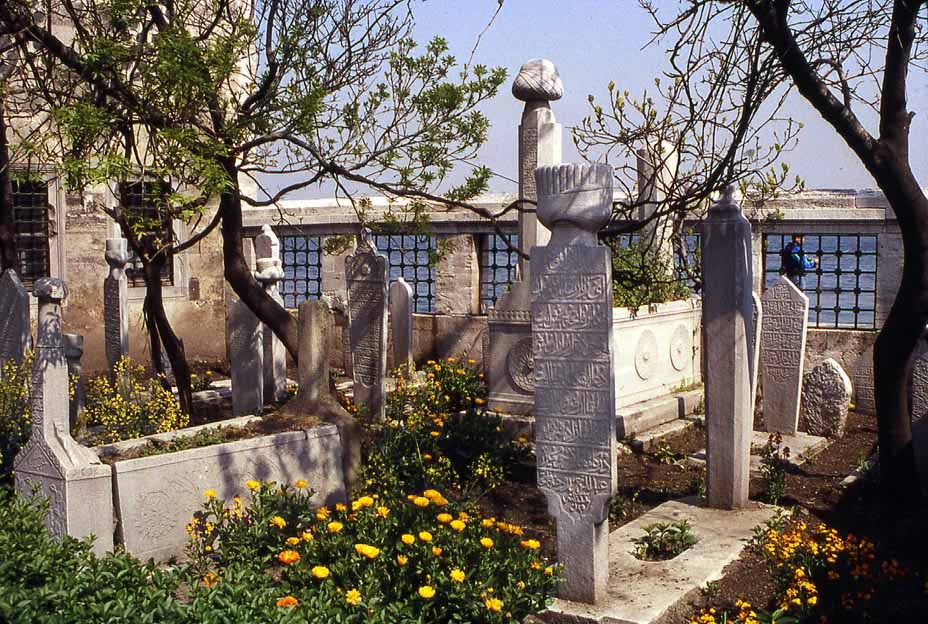
Más sobre Semsi Ahmet Pasa Külliyesi 1580-81
193: Nisanci Mehmet Pasha Mosque 1584 -1589
Istanbul
Nisanci Mehmet Pasha Mosque
1584 -1589
Architect Mimar Sinan
Some scholars do not consider this mosque to be one of Sinan's works, attributing it to Davut Aga. However, if the mosque is studied carefully, it becomes obvious that it constitutes an important step in the development of Sinan's octagonal plan. Here the central dome is no longer fitted into a simple square structure, and the mosque, as in the case of Kadirga Sokollu and Molla Celebi, becomes a truly unified space covered with a single main dome and its integrated semi domes. This basic unity of design is broken however by two cloister vaults covering the entrance and its neighbouring areas. (Text from Evliya, GE-BBS)


Floor plan

Photos and plan from Archnet.org
Más sobre Nisanci Mehmet Pasha Mosque 1584 -1589
194: Erzurum Lala Mustafa Pasa Mosque 1562-1563
Erzurum
Lala Mustafa Pasa Mosque
1562-1563
Architect: Mimar Sinan

Interior

Photos from Archnet.org
Más sobre Erzurum Lala Mustafa Pasa Mosque 1562-1563
195: Van, Köse Hüsrev Pasa Camii 1567-1568, 1587-88
Van, Anatolia
Köse Hüsrev Pasa Camii
1567-1568, 1587-88
Architect Miman Sinan
The mosque below the Van castle.

The mausoleum, which was destroyed 1915 during the Russo-Turkish War

Text and photos from Archnet.org
Más sobre Van, Köse Hüsrev Pasa Camii 1567-1568, 1587-88
196: Diyarbakir Hadim Ali Pasa Camii 1541-1544
Diyarbakir, Anatolia
Hadim Ali Pasa Camii
1541-1544
Architect Mimar Sinan
Ottoman

Interior view of the qibla wall. The mosques of Diyarbakir are carpeted with beautiful local Kurdish rugs

Photos from Archnet.org
Más sobre Diyarbakir Hadim Ali Pasa Camii 1541-1544
197: Diyarbakir Iskender Pasa Camii 1551-1565
Diyarbakir, Anatolia
Iskender Pasa Camii
1551-1565
Architect Mimar Sinan
Ottoman
Built at the same time as Sinan's Sülemaniye in Istanbul (1551- 1558) it is by comparison an unpretentious complex. Interior view

Photo from Archnet.org
Más sobre Diyarbakir Iskender Pasa Camii 1551-1565
198: Diyarbakir Behram Pasa Camii 1564-1573
Diyarbakir, Anatolia
Behram Pasa Camii
1564-1573
Architect Mimar Sinan
Ottoman

Two tone ashlar masonry using the local black stone and knotted columns reminiscent of Seljuk architecture.

Photos from Archnet.org
Más sobre Diyarbakir Behram Pasa Camii 1564-1573
199: Damascus, Sultan Sulayman Mosque 1544-1558
Damascus, Syria
Takiyya Sulaymaniyya, Sultan Sulayman Mosque
1544-1558 (15/67 madrasa)Mimar Sinan

The courtyard with pool

Isometric drawing

Text, photos, and drawing from Archnet.org
Más sobre Damascus, Sultan Sulayman Mosque 1544-1558
200: Adiliyya Mosque Aleppo 1556-1565
Hüsrev Pasha Camii or Adiliyya Mosque
Aleppo 1556 - 1565/66
Architect Mimar Sinan

Floor plan and elevation

Text. photos and plan from Archnet.org
Más sobre Adiliyya Mosque Aleppo 1556-1565
201: Sultan Ahmed - Blue Mosque 1609 - 1619
Istanbul
Sultan Ahmed Mosque
1609 - 1619
Architect Sedefkar Mehmed Aga
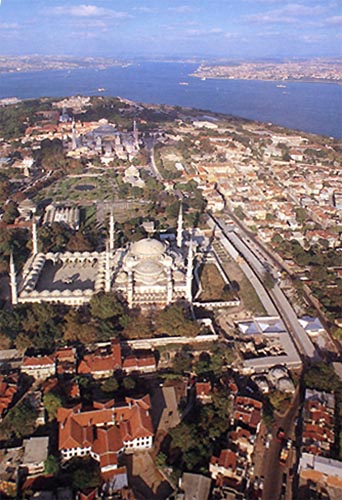
Sultan Ahmed Mosque seen from the Agia Sofia (photos Rolf Gross 1954)
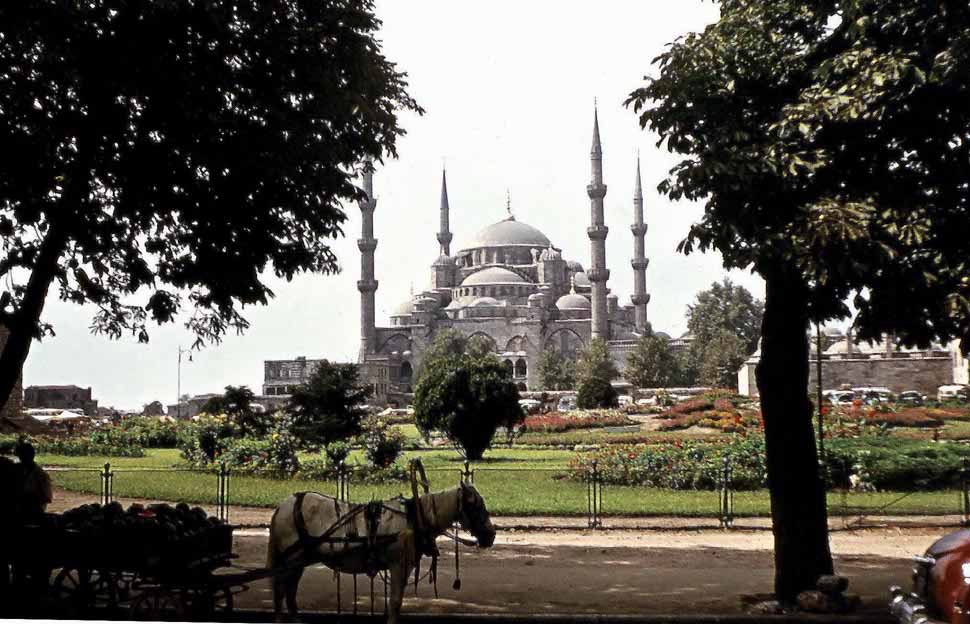

Interior view of one of the four massive columns and the blue tiles that give the mosque its name. The difference in the dynamic structure between Sinan and Mehmed Aga are clearly visible. This dome sits solidly on its four feet and is no match to the stuctural elegance of Sinan's creations. The beautiful tiles distract and hide its architectural details. It seems, after all, justified to call it the Blue Mosque.

Text and last two images from Archnet.org
Más sobre Sultan Ahmed - Blue Mosque 1609 - 1619
202: Yeni Camii - New Mosque 1597-1603, 1661-1663
Istanbul
Yeni Cami "New Mosque"
1597-1603 and 1661-1663
Architect Davud Aga, Dalgic Mehmed Aga, and Mustafa Aga
The first architect was Davud Aga. He was replaced by Dalgic Mehmed Aga after Davud's death in 1598 until work halted in 1603. Mustafa Aga completed the mosque between 1661 and 1663.

Photo by Dick Osseman
The interior is covered with Iznik tiles. Detail showing the springing of an arch from the pier -the transition point from tile panels to painted decoration- and multi-tiered muqarnas cornice above

View looking up at the grand arch separating the central dome and the northeast semi-dome; the gilt cornice of the northeast arcade is seen protruding at top

Vaulting detail showing the transition from the central dome to a semi-dome and its three exedra semi-domes (right); the names of Caliph Ali and his sons Hasan and Huseyn are written on black medallions from left to right

Text and last 3 photos from Archnet.org
Más sobre Yeni Camii - New Mosque 1597-1603, 1661-1663
203: Nuru -Osmaniye Camii 1748-1756
Istanbul
Nuru-Osmaniye Mosque
1748-1756
Architect: Simeon Kalfa
Ottoman Baroque
General view in an older photograph showing the soup-kitchen (left) and the medrese (right) in the foreground

Overall the interior design follows classsical predcedent, the advent of the Baroque is restricted to its external details:
Exterior detail showing transition from dome buttress to corner pier and the cornice of a grand arch supporting the dome

Or the curved courtyard clearly visible from outer space:

Más sobre Nuru -Osmaniye Camii 1748-1756
204: Laleyi (Tulip) Mosque 1760-63
Istanbul
Laleyi (Tulip) Mosque
1760-63
Ottoman Baroque

View looking up at the dome and its eight supporting arches, with the mihrab apse seen at the bottom center. The gilt lattice of the royal lodge appears at the upper left corner. The painting of the domes may be old-fashioned, but the outside details are Ottoman Baroque:

Exterior detail, showing stabilizing turret crowning pier at the courtyard end of the soutwest arcade and curved outline of cornice

Detail from sabil, showing bronze latticework on concave windows and inscriptive panels separated by fluted pilasters below the wide segmented eaves

Text and photos from Archnet.org
Más sobre Laleyi (Tulip) Mosque 1760-63
205: Seyitgazi, Battal Gazi Takkiya 1208-1511
Seyitgazi, Eskishehir
Seyyid Battal Gazi Takkiya
Bektasi Sufi Tekke
1208-1511
Seldjuk-Ottoman
The complex as it appears today consists of domed masonry structures enveloping three sides of a terraced courtyard. The funerary madrasa of �mmühan Hatun is located at the southwest corner, while the tomb of Battal Gazi, khanqah mosque and semahane form a cluster at the southeast corner.
The Seljuk complex was renovated and enlarged during the rule of Ottoman Sultan Bayezid II (1448-1512), establishing it as a convent (khanqah) of the Kalenderi sect. Revered by the larger Alevi, Bektasi and Ahi communities, the khanqah functioned as a Bektasi khanqah from the 17th century until its demise in the early 19th century.
The dervish cells and halls on the east and north sides of the courtyard are all equipped with furnaces; their numerous domes and chimneys dominate a dynamic skyline of the khanqah complex.


Floor plan

Text, photos, and plan from Archnet.org
Más sobre Seyitgazi, Battal Gazi Takkiya 1208-1511
206: Amasya Bayezid Pasa Takkiya 1414
Amasya
Amasya Bayezid Pasa Dervish Tekke and Mosque
1414
Architect: Ebu Bekir bin Mehmed Museymes of Aleppo
Bayezid Pasa was build during the mayoralty of Bayezid Pasa in Amasya in 1414, prior to his appointment as grand vizier by Mehmed I. The pasha acquired a large number of windmills, agricultural land, gardens, stores and public baths in the area to provide income for the religious endowment or waqf (vakif) responsible for the operation and maintenance of the mosque.


Text, photo, and plan from Archnet.org
Más sobre Amasya Bayezid Pasa Takkiya 1414
207: Amasya Yörgüç Pasa Takkiya 1428
Amasya
Yörgüç Pasa Dervish Tekke and Mosque
1428

Photo and text from Archnet.org
Más sobre Amasya Yörgüç Pasa Takkiya 1428
208: Dogubayazid Ishak Pasha Seray 1784
Dogubayazit
Ishak Pasha Seray
1784
Architect probably Ishak Pasha
Rural Palace
The Palace suffered serious damage during several wars, beginning with the Russian siege in 1828. Its entry doors and other wooden architectural pieces were stolen and can be admired in the Ermitage Museum of Sankt Petersburg.
The inner courtyard (enderun) is about twenty by thirty-five meters. It includes an administrative section, a mosque, madrasa (medrese) to the north, servant rooms and stables to the south, a double-story structure housing the guards to the east. The harem section is slightly higher in elevation than the inner courtyard. It is surrounded by pleasure gardens (hasbah�§e) on three sides, and has a ceremonial hall (muayede salonu), kitchen (mutfak), cellar (kiler), baths (hamam) and many rooms. - Visiting the place in 1990 I could rid myself of the impression that this castle had really been a Sufi Tekke. See, for example, the Seygazi Battal Takkiya near Eskeshehir.
(Photos Rolf Gross 1990 and from Archnet.org)

The dome of the mosque (Archnet.org)

Entry gate to the "harem" from the inner courtyard (Archnet.org).

View from a window in the "harem" (Rolf Gross 1990):
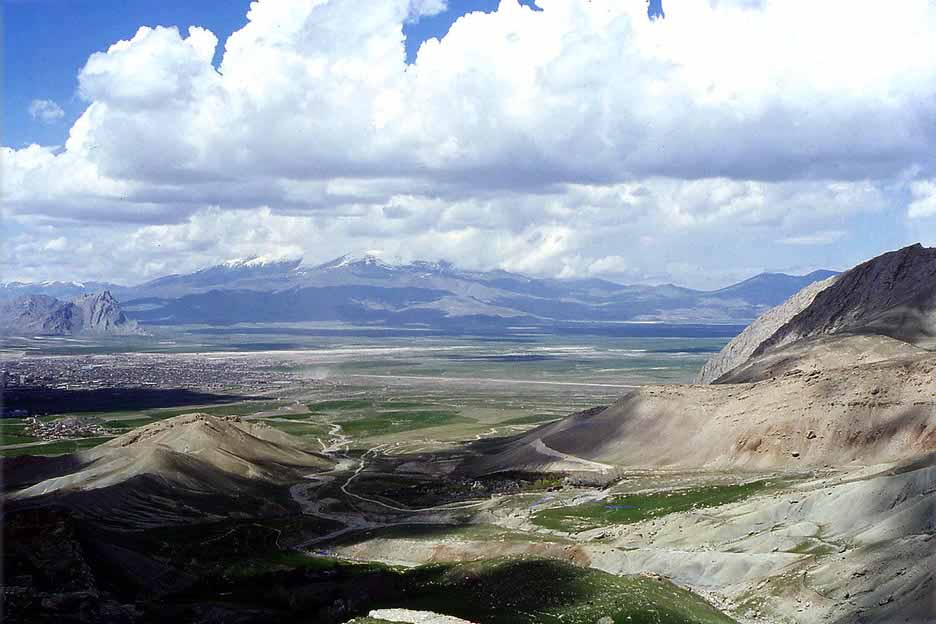
Más sobre Dogubayazid Ishak Pasha Seray 1784
209: Banja Luka Ferhad Pasha Mosque 1579-1580
Banja Luka, Bosnia-Hercegovina
Ferhad Pasha Mosque 1579-1580
The mosque complex included a madrasa (medrese), a Quranic school (mekteb), a dar al-hadith, a bathhouse (hamam), a fountain (Cesme), clocktower (saat kulesi or sahat kula), three tombs (turbe) and a cemetery. A caravanserai (kervansaray) and a market (bedesten or bezistan) were also built at the same time. An inscription over the main entrance of the mosque dated construction to 1579, which corresponds to Ferhad Pasha's rule as the district governor of Bosnia. (sancakbey) (Ottoman Period). Some experts believe the Ottoman architect Sinan was born in this area.
The Ferhad Pasha Complex was blown up during Bosnia's inter-ethnic war on May 7, 1993 in the early morning hours. After destroying the buildings on the site, Serbian nationalists bulldozed and removed the debris of the destruction.

Photo and Text from Archnet.org
Más sobre Banja Luka Ferhad Pasha Mosque 1579-1580
210: Ardabil Shaykh Safi al-Din Tomb 1335-17th cent
Ardabil, Azeri-Iran
Shaykh Safi al-Din Tomb
1335-17th cent
Il-Khanid, Safavid

Photo and text from Archnet.org
Más sobre Ardabil Shaykh Safi al-Din Tomb 1335-17th cent
211: Tabriz Masjid-i Muzaffariyya 1465
Tabriz, Iran
Masjid-i Muzaffariyya, Blue Mosque
1465
Qara Qoyunlu
The mosque, now in ruins, was once a complex which included a tomb, cistern, library and khanqah (mental institution). The function of the remaining building, itself in a state of ruin, has not been definitively identified (Sufi Tekke?). Named Blue Mosque for its unrivalled tile decor of which there are remnants. Both interior and exterior surfaces were once covered in a variety of tiles. The remains of tile mosaics, underglaze-painted and overglaze-painted tiles and luster tiles attest to the richness of the decorative scheme. Patterns are rendered in subtle colors with extensive use of cobalt blue as a ground for inscriptions and arabesque designs in gold and white. The dome was a deep blue, stenciled with gold patterns.
Extensive rebuilding took place between 1950 and 1966. The dome over the central chamber dates from this period, as do the undecorated interior walls.
The following photos (1999 after the restoration) remind one in design, detail, and layout of the sophisticated tile moasics in Timur's Aq Serai in Shakh-i Zabz (around 1400).




Text and photos from Archnet.org
Más sobre Tabriz Masjid-i Muzaffariyya 1465
212: Mahan, Nur ad-Din Ni'matullah Shrine 1437
Mahan, Iran
Shah Nur ad-Din Ni'matullah Vali Shrine
1437 (Safavid reconstruction 1601)
Timurid, Safavid, Qajar
The shrine complex as it now stands, comprises three courtyards arranged axially communicating with dependent structures. The earliest work is attributed to the Bahmanid ruler Ahmed I Vali who erected the sanctuary chamber in 1436. Shah Abbas I undertook extensions and renovations in 1601, including renovation or reconstruction of the dome.
View of the shrine

Aerial view of the dome

Minaret and detail of roof construction

Construction of the small domes on the roof. Armenian influences durng Shah Abbas' time?

Detail

Text and photos fromArchnet.org
Más sobre Mahan, Nur ad-Din Ni'matullah Shrine 1437
213: Kerman Masjid-e Jame 1349/ 1559
Kerman, Iran
Masjid-e Jame - Friday Mosque
1349 and 1559
Muzaffarid and Safavid
North portal (14th cent) and, to the left, the tracts added in the 16th cent.

Interior detail of north portal, showing tile mosaic with kufic inscriptions (1349)

Detail of the tile covering (1559)

Text and photos from Archnet.org
Más sobre Kerman Masjid-e Jame 1349/ 1559
214: Kerman Ganj-i Ali Khan Caravansaray 1598
Kerman, Iran
Ganj-i Ali Khan Caravanserai and Mosque
1598
Architect Ustad Muhammad Yazd
Safavid
The plan of the caravanserai is based on the four-iwan typology, with double-story halls centered on tall iwans enveloping four sides of an open courtyard. There is an octagonal fountain at the center of the courtyard which is chamfered at the corners. The caravanserai measures 32 by 23 meters. It has a small domed mosque at one corner that measures 5.5 by 5 meters.

Northern tract

Detail of tiled spandrels of north ivan - note the figurative image of an angel (Gabriel?)

Text and photos from Archnet.org
Más sobre Kerman Ganj-i Ali Khan Caravansaray 1598
215: Kerman Hamam-e Ganj Ali Khan Bath 1611
Kerman, Iran
Hamam-e Ganj Ali Khan
Bath Museum
1611
Safavid
Interior: hot room with octagonal pool. (With wax mannequins!!)

Dome of cool room

Text and photos from Archnet.org
Más sobre Kerman Hamam-e Ganj Ali Khan Bath 1611
216: Kerman Windtowers 16th cent
Kerman, Iran
Wind towers
Kerman Bazaar
16th cent
Towers designed to catch the eveing breeze and direct it into Kerman's extensive covered bazaars (see the domed passage ways on the GE image).

Photo from Archnet.org
Más sobre Kerman Windtowers 16th cent
217: Bam Citadel 1st, 16-17th cent
Bam, Iran
Citadel, Arg-e-Bam
originally built 224-637, rebuilt 1502-1722
Mosque 866-903
Sassanid, Saffanid, Safavid
This marker is for a castle and a lost city not a religious building. The excuse for including it is that it is a formidable place - with excellent documentation in Archnet.org
The ruined city of Arg-e-Bam is made entirely of mud bricks, clay, straw, and the trunks of palm trees. The city was originally founded during the Sassanian period (224-637 AD) and while some of the surviving structures date from before the 12th century, most of what remains was built during the Safavid period (1502-1722).
During Safavid times, the city occupied six square kilometers and had between 9000 and 13,000 inhabitants. Bam prospered because of pilgrims visiting its Zoroastrian fire temple (dating to early Sassanian times) and as a commercial and trading center on the famous Silk Road. Upon the site of the Zoroastrian temple the Jame Mosque was built during the Saffarian period (866-903 AD). Adjacent to the mosque is the tomb of Mirza Naiim, a mystic and astronomer who lived three hundred years ago.
Bam declined following an invasion by Afghans in 1722 and another by invaders from Shiraz in 1810. The city was used as a barracks for the army until 1932 and then completely abandoned. Intensive restoration work began in 1953 and continued through 2003.
On 26 December 2003, an 6.7 magnitude earthquake struck Bam and claimed more than 40'000 lives. Over 70% of the buildings were completelty destroyed.

Model of the Safavid city

Photograph from the crenalleted mud walls into the reconstructed city (1996)

Children playing soccer in the ruins (1996)

Text and photos from Archnet.org
Más sobre Bam Citadel 1st, 16-17th cent
218: Isfahan Naghshe Jahan Square 1602-1620
Isfahan, Iran
Naghshe Jahan Square
The square is surrounded by buildings from the Safavid era. The Shah Mosque is situated on the south side of this square. On the west side you can find Ali Qapu Palace. Sheikh Lotf Allah Mosque is situated on the eastern side of this square. The northern side opens into the Isfahan Grand Bazaar.
Naghshe Jahan Square looking south towards the Shah Abbas complex
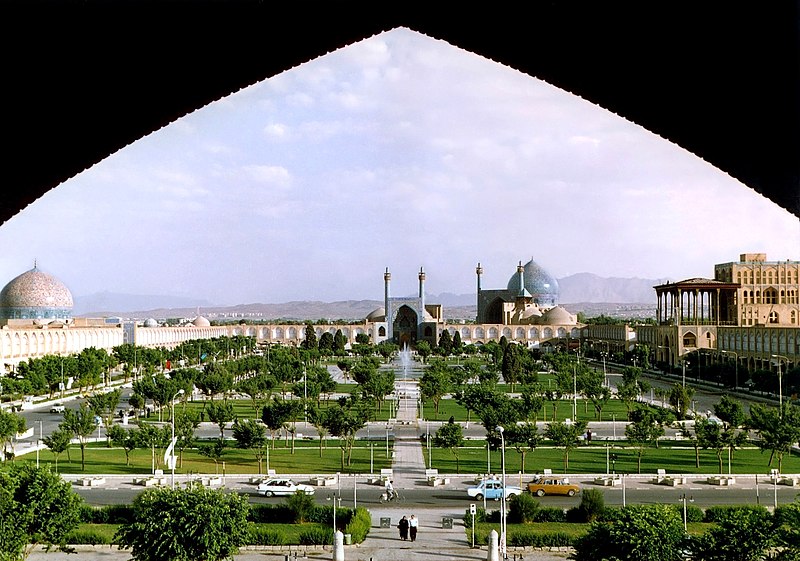
Text and photo from Wikipedia - Isfahan.
Más sobre Isfahan Naghshe Jahan Square 1602-1620
219: New Julfa 1606-20th cent
New Julfa, Isfahan, Iran
Armenian quarter
1606-20th cent.
1605 Abbas I forcibly moved more than 150 000 Armenias from northwest Iran (Azerbaidjan) into new quarters at Isfahan, which he named New Julfa, after the city where most of them came from. The Armenians were excellent merchants, brought their knowledge of seri-culture with them, and were skilled master builders. It is probably no exaggeration that Shah Abbas I's ambitous urban projects in Isfahan and especially the mosques and medrese of the Safavid period were built by Armenian craftsmen.
In exchange for their services the Armenian community was given privileges which far exceeded those of the contemporary Ottoman Empire. See New Julfa in Wikepedia
Más sobre New Julfa 1606-20th cent
220: Isfahan Sheikh Lutfallah Mosque 1603-1619
Isfahan, Iran
Sheikh Lutfallah Mosque
1603-1619
Safavid



Text and photos from Archnet.org
Más sobre Isfahan Sheikh Lutfallah Mosque 1603-1619
221: Isfahan Shah Abbas I Mosque 1611-1638
Isfahan, Iran
Shah Abbas I Mosque
1611-1638
Safavid
Formally reflecting the bazaar portal on the north wall of the meydan, the entrance portal to the Mosque is recessed into the center of the arcade on the south wall. Between the entrance portal and the central four-iwan courtyard is a domed vestibule that enters the apse of the north iwan at a 45 degree angle. This transition accommodates the angle between the meydan axis with which the portal is aligned, and the mosque orientation toward Mecca.


Text and photos from Archnet.org

Photo by by Rezakhaniha Rana, Panoramio

Photo byby hamzeh.karbasi, Panoramio
Más sobre Isfahan Shah Abbas I Mosque 1611-1638
222: Isfahan Masjid-i Jami 8th - 17th cent
Isfahan, Iran
Masjid-i Jami
8th - 17th cent
Buyid, Seljuk, Safavid
The Friday Mosque as it stands now is the result of continual construction, reconstruction, additions and renovations on the site from around 771 to the end of the twentieth century. Archaeological excavation has determined an Abbasid hypostyle mosque in place by the 10th century. Buyid construction lined a fa�§ade around the courtyard and added two minarets that are the earliest example of the double minaret on record.
Construction under the Seljuks included the addition of two brick domed chambers, for which the mosque is renowned. The south dome was built to house the mihrab in 1086-87 by Nizam al-Mulk, the famous vizier of Malik Shah, and was larger than any dome known at its time. The north dome was constructed a year later by Nizam al-Mulk's rival Taj al-Mulk.
further additions and modifications took place incorporating elements from the Mongols, Muzzafarids, Timurids and Safavids.

Text and photo from Archnet.org

Photo by Vojta Srejber, Panoramio
 BR>
BR>Photo by Anders Hedelund, Panoramio
Más sobre Isfahan Masjid-i Jami 8th - 17th cent
223: Isfahan Masjid-i Hakim Mosque 1656-1662
Isfahan, Iran
Masjid-i Hakim - Mosque of Al-Hakim
1656-1662
Safavid

Northern corner of courtyard wirh screenwall of the medresa on the left.

Axiometric view of the mosque

Text, photos, and plan from Archnet.org
Más sobre Isfahan Masjid-i Hakim Mosque 1656-1662
224: Isfahan Madar-i Shah Medresa 1706-1714
Isfahan, Iran
Madar-i Shah Madrasa
1706-1714
Safavid
Commissioned by the last Safavid Shah, Husayn I, the Madrasa Madar-i Shah forms the western side of a complex lying perpendicular to the Chahar Bagh. Abutting the madrasa is a caravanserai (renovated to become the Shah Abbas Hotel) beyond which lie stables. These structures are connected by a bazaar, which lines each on their northern side. All four structures exhibit a precise symmetry and are composed with a strict axial concern for the Chahar Bagh.
The tile work is not of the quality available at the time of Shah Abbas' projects; the decoration is limited to geometric patterns instead of intricate floral designs. Blair and Bloom consider the Madar-i Shah complex 'the last major architectural achievement from the Safavid period', noting that 'the expansive scale and confident massing of forms set the style for architects in the following two centuries'.
Exterior view of the dome during restoration.

Text and photo from Archnet.org
Más sobre Isfahan Madar-i Shah Medresa 1706-1714
225: Multan, Shah Rukn-i-'Alam Tomb 1320-1324
Multan, Pakistan
Shah Rukn-i-'Alam Mausoleum
1320-1324
Tughluqid
Architect Muhammad Wali Ullah Khan
Also known as the Rukn-i-Alam or the pillar of the sky. It is the most prominent feature on the Multani skyline.


Text and photos from Archnet.org
Más sobre Multan, Shah Rukn-i-'Alam Tomb 1320-1324
226: Dera Gazi Khan Tomb of Khazi Khan 1494
Dera Gazi Khan, Pakistan
Tomb of Khazi Khan
1494
Timurid
I did not find the exact location of this unusual tomb of a gazi, a hero of the holy war.

Photo from Archnet.org
Más sobre Dera Gazi Khan Tomb of Khazi Khan 1494
227: Lahore Badshahi Mosque 1673-1674
Lahore, Pakistan
Badshahi Mosque
1673-1674, restored 1983
Mughal


During restoration (1983)

Text and photos from Archnet.org
Más sobre Lahore Badshahi Mosque 1673-1674
228: Lahore Wazir Khan Mosque 1634-1635
Lahore, Pakistan
Wazir Khan Mosque
1634-1635
Mughal

One of the unique painted minarets

Interior before restauration

In 1977 the mosque was extensively restored using local craftsmen and revived ancient techniques.

Text and photos from Archnet.org
Más sobre Lahore Wazir Khan Mosque 1634-1635
229: Muziris-Kondugallur, Kerala
Kondugallur has a history (see Wikipedia for a poorly written article) It was known as Muziris to Pliny the Elder (23 -79 AD) who describes it as primum emporium Indiae.
The Greek explorer, Hippalus (1st cent BC), the discoverer of the monsoon trade winds, described this port. Roman coins have been found here in 2000.
Apparently in the 1st cent BC a small community of Jewish traders existed in Kondugallur, and there are conjectures of a much earlier presence of Jewish traders on the Malabar Coast.
So, the "legend" that Malik Ibn Dinar landed here 625 with 20 Muselmans and built the second earliest mosque after Medina, is not entirely improbable: a small mosque resembling the "palm hut of the Prophet" but of no other architectural interest. This legend assumes near certainty when one discovers that the oldest Christian settlement (52 AD) in India is in the same place. There exist a church in which St. Thomas, the Syrian founder of the Christian community is buried.
Más sobre Muziris-Kondugallur, Kerala
230: Kondugallur Cheraman Perumal Juma Masjid 625 AD
Kondugallur, Kerala
Cheraman Perumal Juma Masjid
625
by Malik Ibn Dinar

Photo from Wikipedia, Kondugallur
Más sobre Kondugallur Cheraman Perumal Juma Masjid 625 AD
231: Delhi, Mosque of Qutb al-Din Aibak 1197-1199, 1305
Delhi, India
Mosque of Qutb al-Din Aibak
1197-1199, 1305
Mu'izzi
Ruins of Qutb Mosque and the Minar.

Photo by Navin Bhatt, Panoramio
Khalji also added a gateway in the southeast, known as the Alai Darwaza. This richly decorated gate is renowned for its composition, and for being the first use of the red sandstone and white marble juxtaposition, soon to become a favorite facing device.

Photo by Arturo GarciÂa, Panoramio
The original mosque was built using the components of the Hindu temples it replaced. Columns intricately carved with Hindu motifs were used intact.

Photo by Arturo GarciÂa, Panoramio
Más sobre Delhi, Mosque of Qutb al-Din Aibak 1197-1199, 1305
232: Ajmer Ardhai-din-ka Jhompra Masjid 1200-1206
Ajmer, Rajastan
Ardhai-din-ka Jhompra Masjid
1200-1206
Mu'izzi

Photo by SINHA from Panoramio
Más sobre Ajmer Ardhai-din-ka Jhompra Masjid 1200-1206
233: Pandua Adina Masjid 1375
Pandua, Bengal
Adina Masjid
1375
Tughluqid
Built by Sikandar Shah, the second sultan of the Ilyas dynasty, the Adina mosque is the only hypostyle mosque in Bengal. Similar in plan to the Great Mosque of Damascus, it is a rectangular, hypostyle structure, with an open central courtyard.
A series of secondary mihrabs runs along the whole western wall. In total, the 39 mihrabs, the minbar and other ornamentations are rigorously Islamic in their general conception but Hindu in almost all the details: small scalloped columns and plinths in the shape of lotus flowers, corbels, trilobate arches each with its sharp end cuspidated with a vase of flowers, volutes representing leaves, rhomboid lozenges and friezes of lotus petals. Along with the Hindu motifs, the interior of the mihrab niche is divided into panels containing the Islamic motif of the 'hanging lamp' commonly used in Bengal and is thought to be the visual representation of the Surah "Al-Nur", the light.
Triple-aisled south cloister viewed from southeastern corner of mosque

Interior columns

Central nave and main mihrab. The barrel vault has collapsed

One of the naves with "lamp" motif decorations.

Text and photos from Archnet.org
Más sobre Pandua Adina Masjid 1375
234: Srinagar Shah-e-Hamadan Mosque 1395
Srinagar, Kashmir
Shah-e-Hamadan Mosque
1395
Ravaged by fire in 1480, it was reconstructed and expanded by Sultan Hassan Shah. In 1493 it was demolished and rebuilt as a two-story structure. Again in 1731 fire destroyed the mosque; Abul Barkat Khan reconstructed it.


Main entrance to Mosque

Text and photos from Archnet.org
Más sobre Srinagar Shah-e-Hamadan Mosque 1395
235: Ahmedabad Jami' Masjid 1424
Ahmedabad, Gujarat
Jamii Masjid
1424
Bahmanid

Interior view of the prayer hall from gallery level

Text and photos from Archnet.org
Más sobre Ahmedabad Jami' Masjid 1424
236: Delhi Mausoleum of Humayun 1562-72
Delhi, India
Mausoleum of Humayun
1562-72
Mughal
The tomb design is attributed to Sayyid Muhammad and his father, Mirak Sayyid Ghiyath (Mirak Mirza Ghiyas), Persian architects and poets active at the Timurid and later the Mughal courts.

Cross-section showing the double-shell dome. See the Mausoleum of Il-Khan �ljeitü 1307-1313 in Sultaniyya

Text and Photos from Archnet.org
Más sobre Delhi Mausoleum of Humayun 1562-72
237: Fatehpur Sikri Shayk Salim Chishti Tomb 1571-1580
Fatehpur Sikri, Rajesthan
Shayk Salim Chishti Tomb, Friday Mosque Complex
1571-1580
Mughal
Shaikh Salim, a Chishti Sufi who lived in the village of Sikri came to imperial notice when he correctly predicted the birth of Akbar's son Jahangir. It was to honor this saint that Akbar, in 1571, established the palatial-religious complex of Fatehpur Sikri on the site of Shaikh Salim's village, making it his capital. The tomb of Shaikh Salim is of white marble, and sits in an enclosure with a pool. The entrance porch is held up by unusual, serpant-like supports. A verandah enclosed by a finely carved perforated screen surrounds the main tomb hall. At its center is the cenotaph, sheltered by a canopy decorated with mother-of-pearl. A wide marble dome covers the structure.


Text and photos from Archnet.org
Más sobre Fatehpur Sikri Shayk Salim Chishti Tomb 1571-1580
238: Fatehpur Sikri, Jami Masjid 1571-1574
Fatehpur Sikri, Rajasthan
Jami Masjid
1571-1574
The mosque, known as the 'Glory of Fatehpur Sikri', on the western side of the religious and palatial complex of the city, was built by Akbar to honor Shaikh Salim, the Chishti saint. It was the largest mosque of the Mughal Empire in its time. The main entrance into its large courtyard is through the Buland Darwaza, an enormous monumental gate. A large pistaq, a type of high arched gate of Timurid origins, leads into the main prayer hall, which is finished in red sandstone and white inlay. Paint and gilt add to the intricate ornamentation. Flanking the main hall are large, pillared side wings.

Exerior view from the east showing the arched entryway and colonnade.

Detail of the marble screens on the external wall

Text and photos from Archnet.org
Más sobre Fatehpur Sikri, Jami Masjid 1571-1574
239: Fatephur Sikri Jodh Bai Palace 16th cent
Fatephur Sikri, Rajesthan
Jodh Bai Palace
16th cen
Moghul
Also known as "Shabistan-I-Iqbal" (Principal Haram Sara), it is the largest and most important zenana, or palace for the imperial women. Baths and latrines project to the south, a viaduct and splendid balcony, to the north. It has but one entrance facing east across a wide paved courtyard. It used to be connected to the Emperor's Daulat Khana, which was destroyed.

Text and photos from Archnet.org
Más sobre Fatephur Sikri Jodh Bai Palace 16th cent
240: Agra Taj Mahal 1632-1648
Agra, India
Taj Mahal
1632-1648
Mughal
It seems silly to add new photographs of the fabled building to the hundreds of Panoramios already on GE. So, I'll chose some of the better ones. Here is a poetic photo by from across the Yamuna River.

Photo by joseleer Panoramio
Another photo by josleeser shows that the complex also includes an architecturally interesting mosque, which is usually cut out of the standard pictures.

Photo by joseleer Panoramio
The Mosque.

photo by Jorgen K H Knudsen Panoramio
And finally one of the best of the frontal views among the Panoramios photos.

Photo BigMoe Panoramio
Más sobre Agra Taj Mahal 1632-1648
241: Delhi Jama Masjid Great Mosque 1644-58
Old Delhi, India
Jama Masjid, Great Mosque
1644-58
Moghul

Photo by ramses II, Panoramio
Interior.

Photo by by eulogio Panoramio
Dehli from the minaret.

Photo by Richard Guy Panoramio
Más sobre Delhi Jama Masjid Great Mosque 1644-58
242: Guangzhou Huaisheng Great Mosque 625
Guangzhou, China
Huaisheng Great Mosque and minaret
625
Hui

The very un-Chinese "Light Tower"

Interior of prayer hall: mihrab

Text and photos from Archnet.org
Más sobre Guangzhou Huaisheng Great Mosque 625
243: Xi'an Great Mosque 1398 - 1980
Xian, China
Great Mosque
1368-1398, restored 1980
Hui

Text and photo from Archnet.org
Más sobre Xi'an Great Mosque 1398 - 1980
244: Kashgar Aidgah Mosque 1426
Kashgar Xinjiang, China
Aidgah Mosque
1426, rebuilt in the 19th cent
Khoja Khanate
Although the mosque was probably first built in the 1440's when Islam was introduced to Kashgar, the layout and most of the built fabric date to the nineteenth century.

Text and photo from Archnet.org
Más sobre Kashgar Aidgah Mosque 1426
245: Matmata
Troglytic Berber villagehttp://mw2.google.com/mw-panoramio/photos/medium/1389798.jpgHouses in the Medinahttp://www.panoramio.com/photos/original/1828547.jpghttp://www.panoramio.com/photos/original/5382823.jpg
Más sobre Matmata
246: Mosque de Midoun
http://mw2.google.com/mw-panoramio/photos/medium/6189993.jpghttp://www.panoramio.com/photo/6189993
Más sobre Mosque de Midoun
247: Unnamed Mosque
http://www.panoramio.com/photos/original/2938068.jpghttp://www.panoramio.com/photo/2938068
Más sobre Unnamed Mosque
248: The Mosques of Djerba
Djerba, Tunisia





Más sobre The Mosques of Djerba
249: Mosque de Maraboute
http://www.panoramio.com/photos/original/2518850.jpghttp://www.panoramio.com/photo/2518850
Más sobre Mosque de Maraboute
250: Mosque Mahboubin
http://www.panoramio.com/photos/original/3059068.jpghttp://www.panoramio.com/photo/2518850
Más sobre Mosque Mahboubin
251: Unnamed Mosque
http://www.panoramio.com/photos/original/5042646.jpghttp://www.panoramio.com/photo/5042646
Más sobre Unnamed Mosque
252: Mosque Fadhloun
http://www.panoramio.com/photos/original/3548062.jpghttp://www.panoramio.com/photo/3548062
Más sobre Mosque Fadhloun
253: Timbuktu Djingarey Ber Mosque 1327, restored 2000
Timbuktu, Mali
Djingarey Ber Mosque
1327, restored 2000

The rooftop minaret

Text and photographs from Archnet.org
Más sobre Timbuktu Djingarey Ber Mosque 1327, restored 2000
254: Gao, Tomb and Mosque of Askia 16th cent
Gao, Mali
Tomb of Askia Mohammed
16th cent
Songhay
The tomb itself is built of mudbrick measuring about 14 by 18 meters by 10 m high. The earthen exterior walls are distinguished by protruding toron, or stakes, of acacia wood. Such stakes bristling from the walls provide a permanent scaffolding for replastering the mud that has washed away. The tomb is enclosed within the eight-foot wall of the larger mosque complex the area of which is about 45 by 50 meters.For an additional description see Archnet.org

Interior passage of the mosque's compound surrounding the tomb

Text and photos from Archnet.org
Más sobre Gao, Tomb and Mosque of Askia 16th cent
295: Bursa First Capital of Ottoman Empire
Bursa becomes the Capital of the Osman Empire until the fall of Constantinople. Fall of Nikomedia (Ismid) 1337.
Más sobre Bursa First Capital of Ottoman Empire
296: Istanbul Capital of Ottoman Empire 1454-1921
Más sobre Istanbul Capital of Ottoman Empire 1454-1921